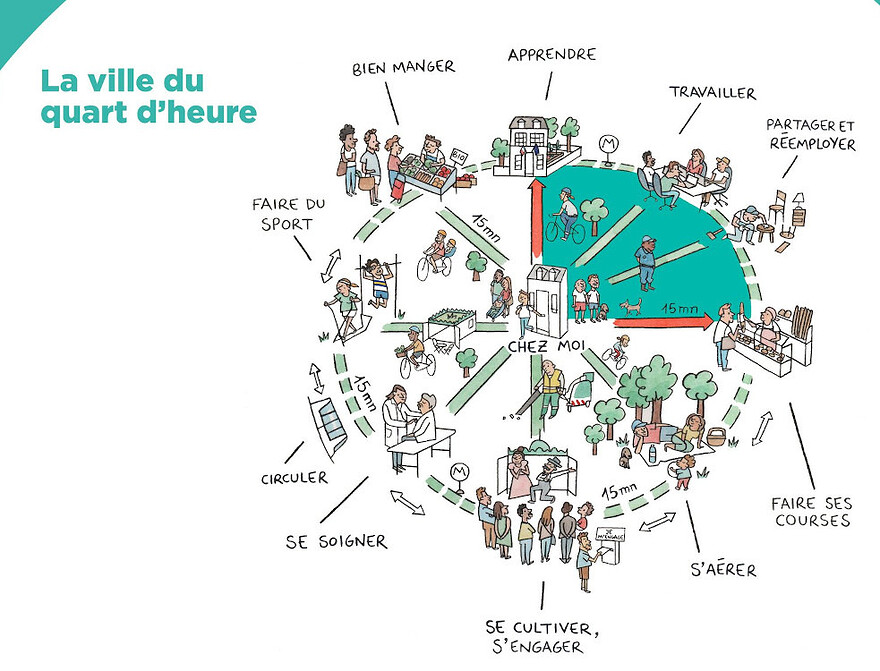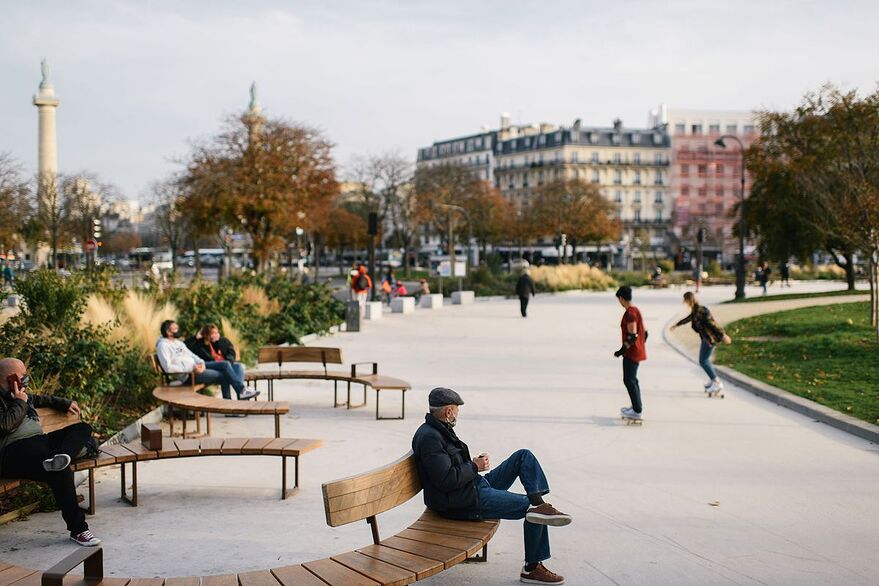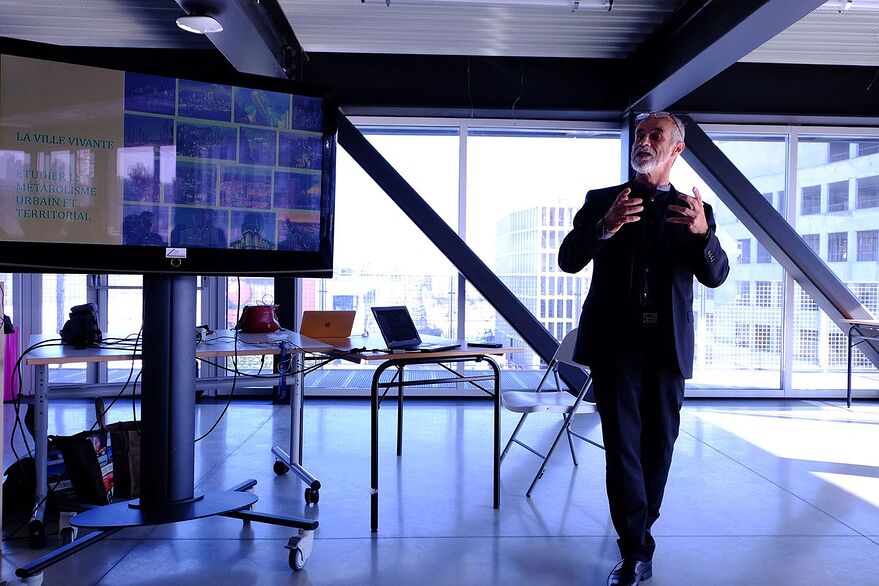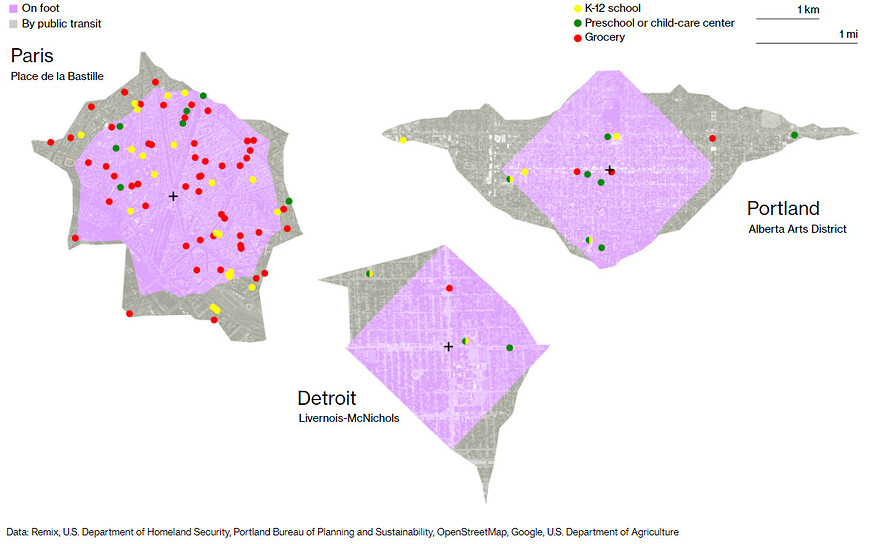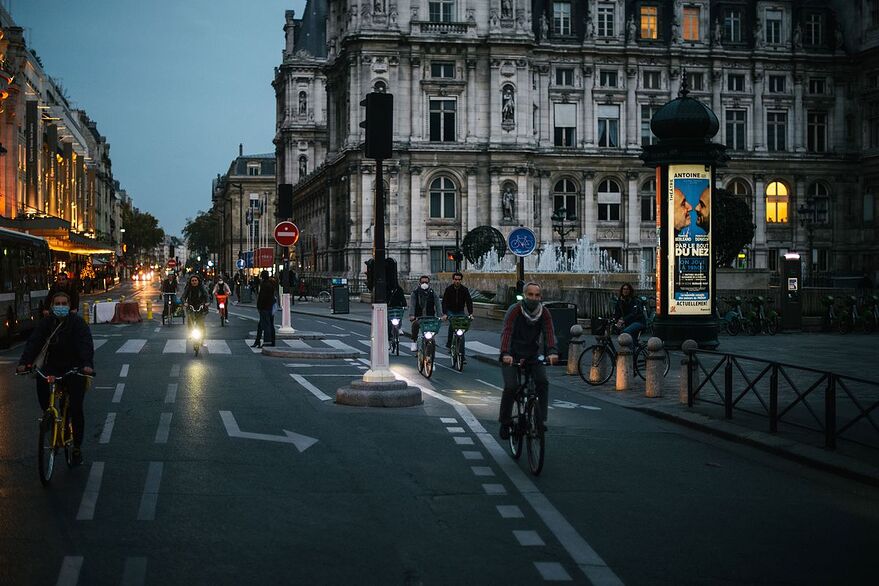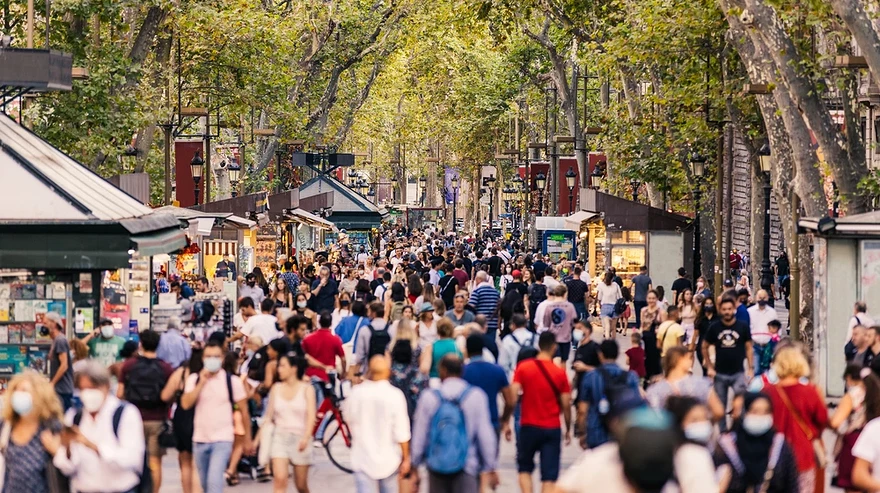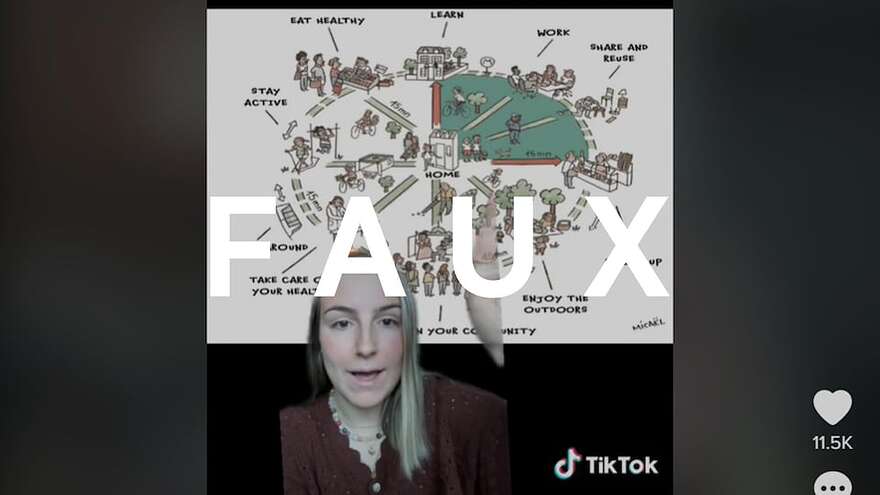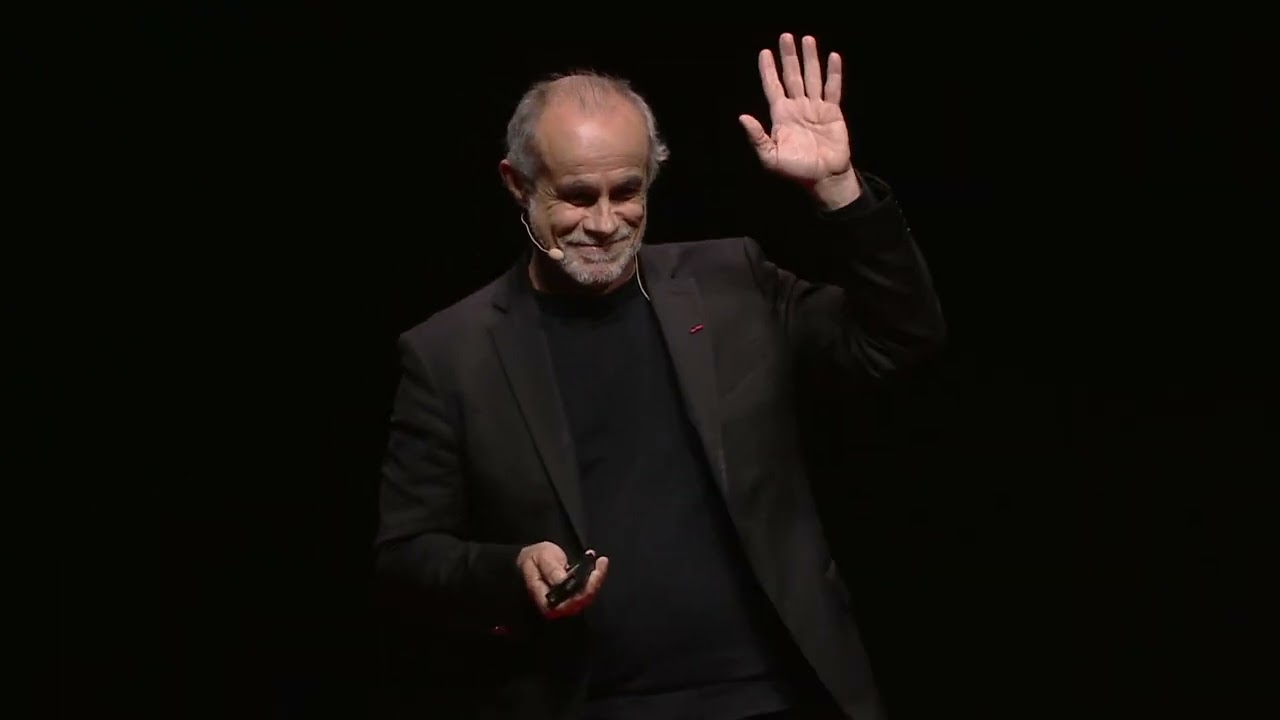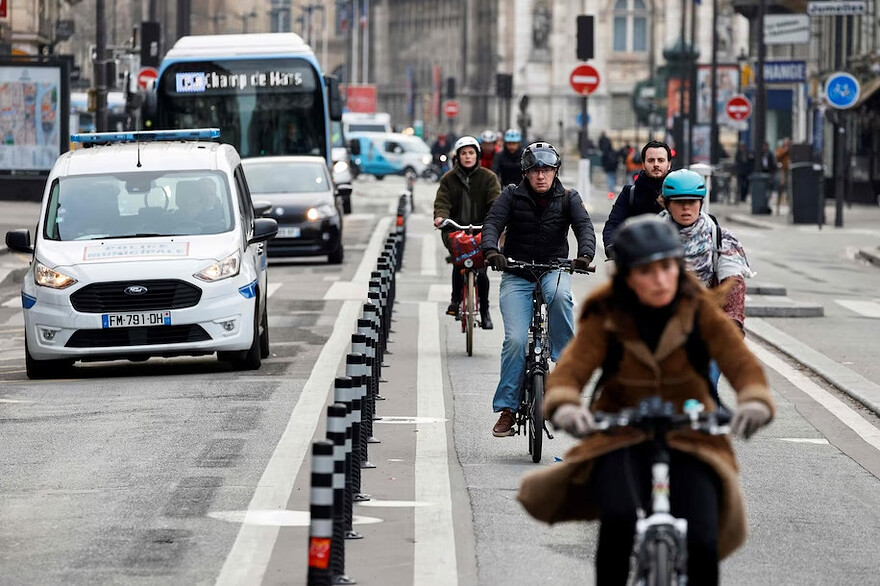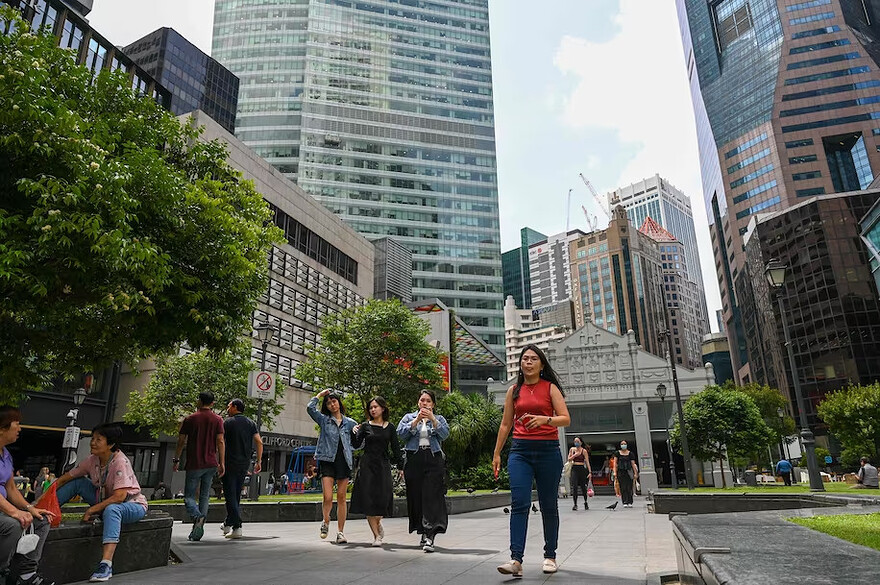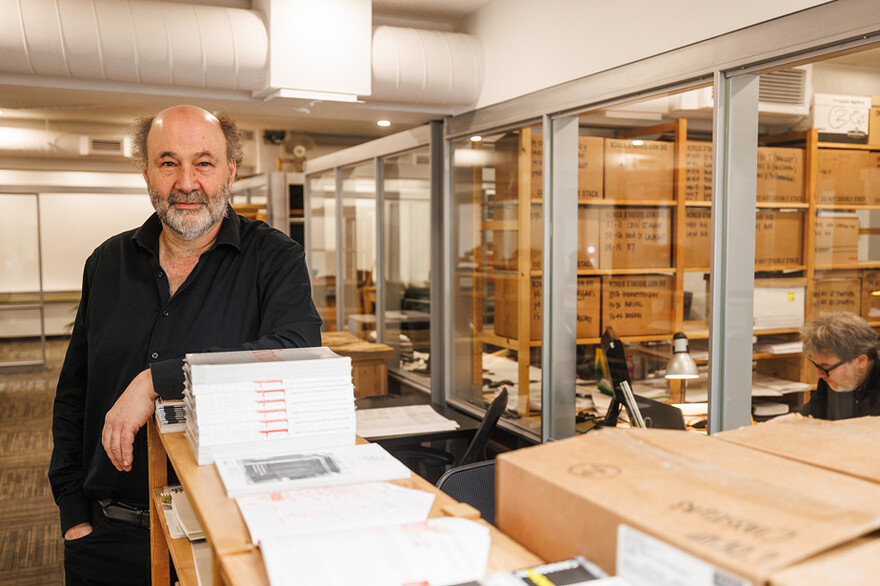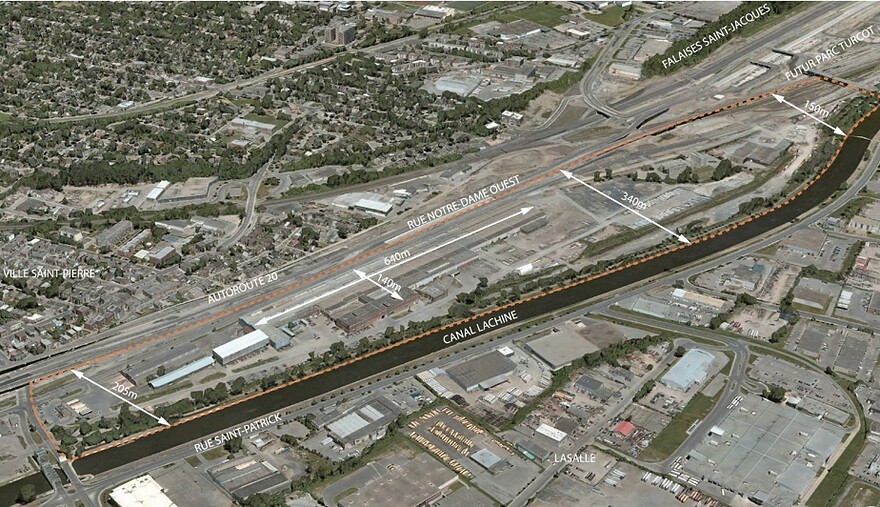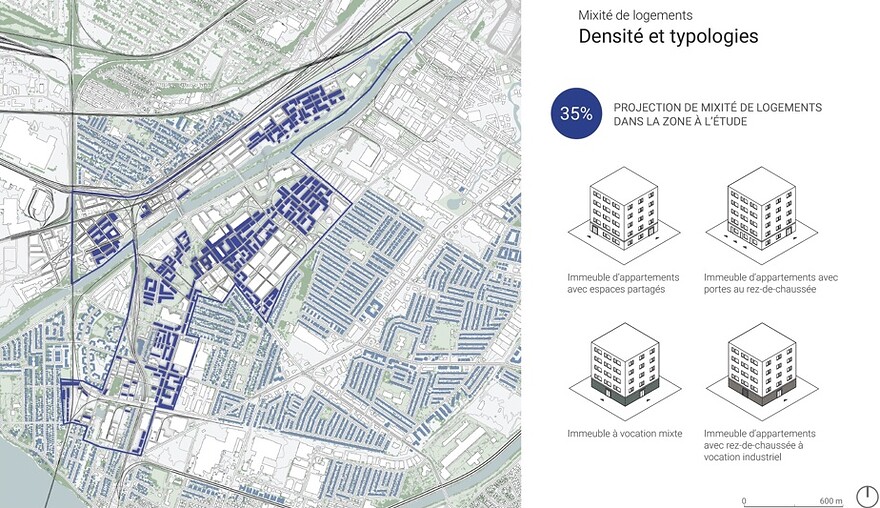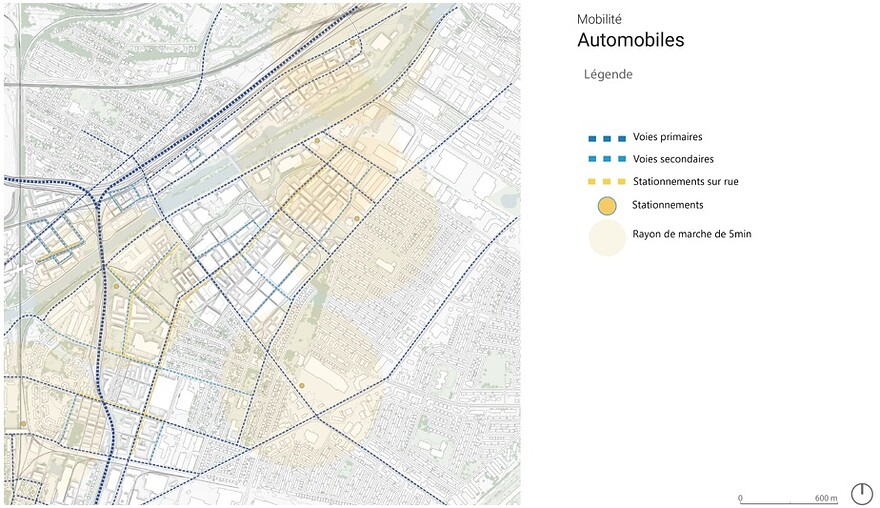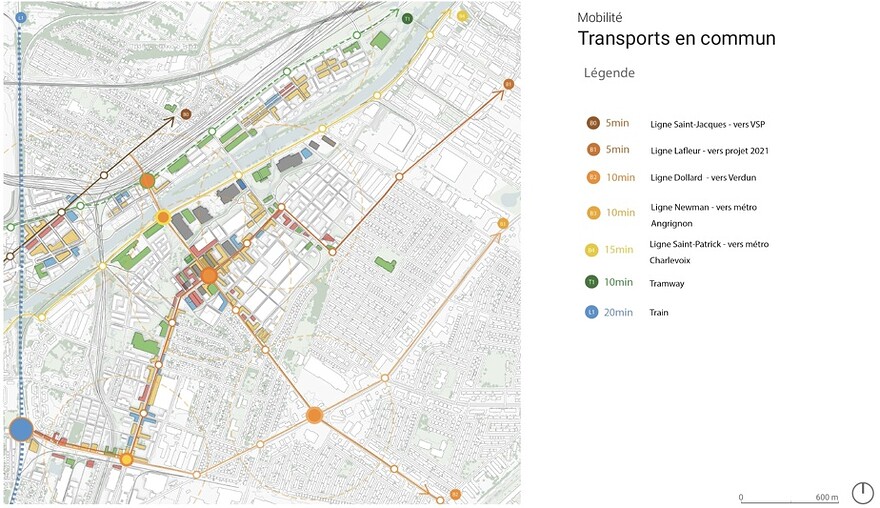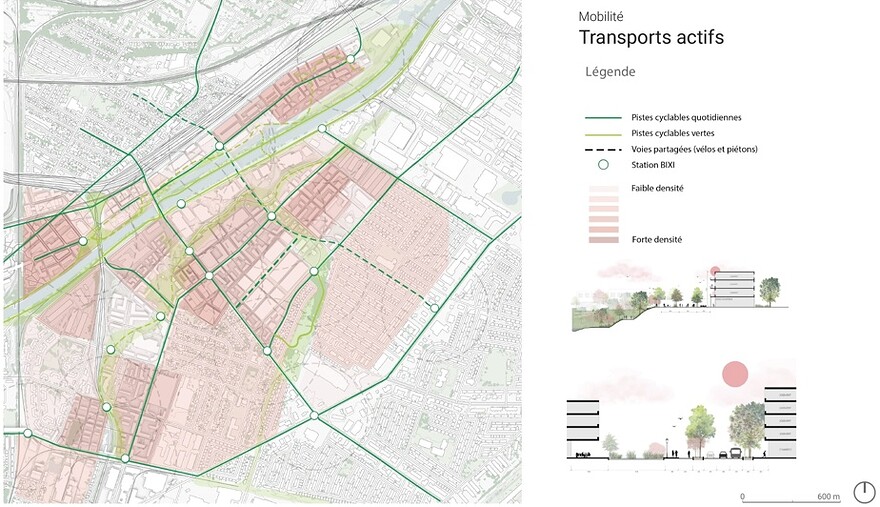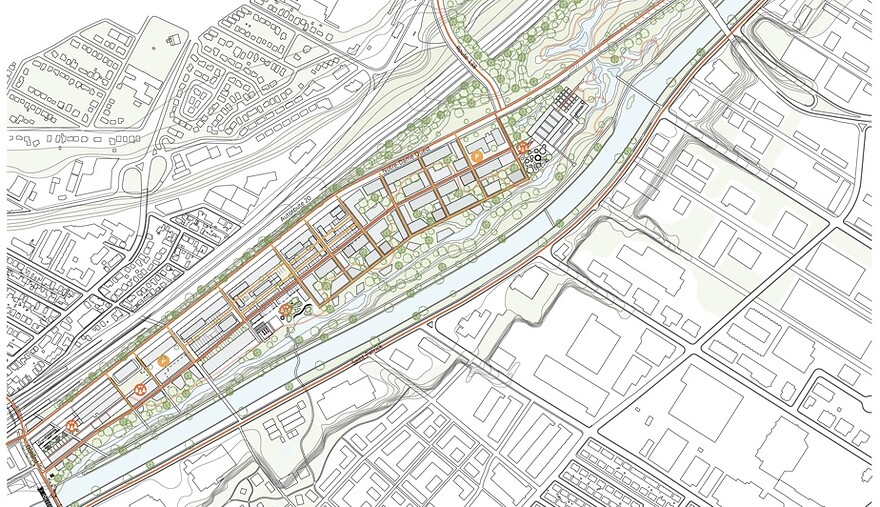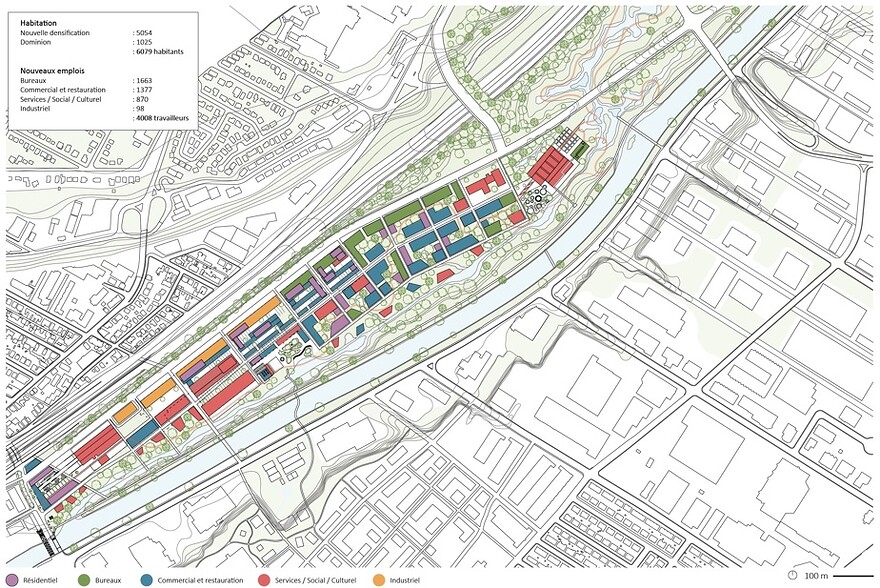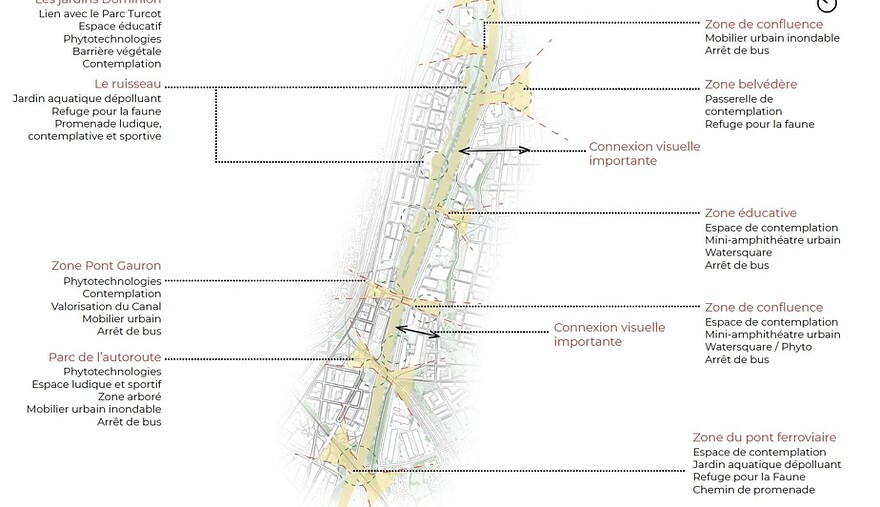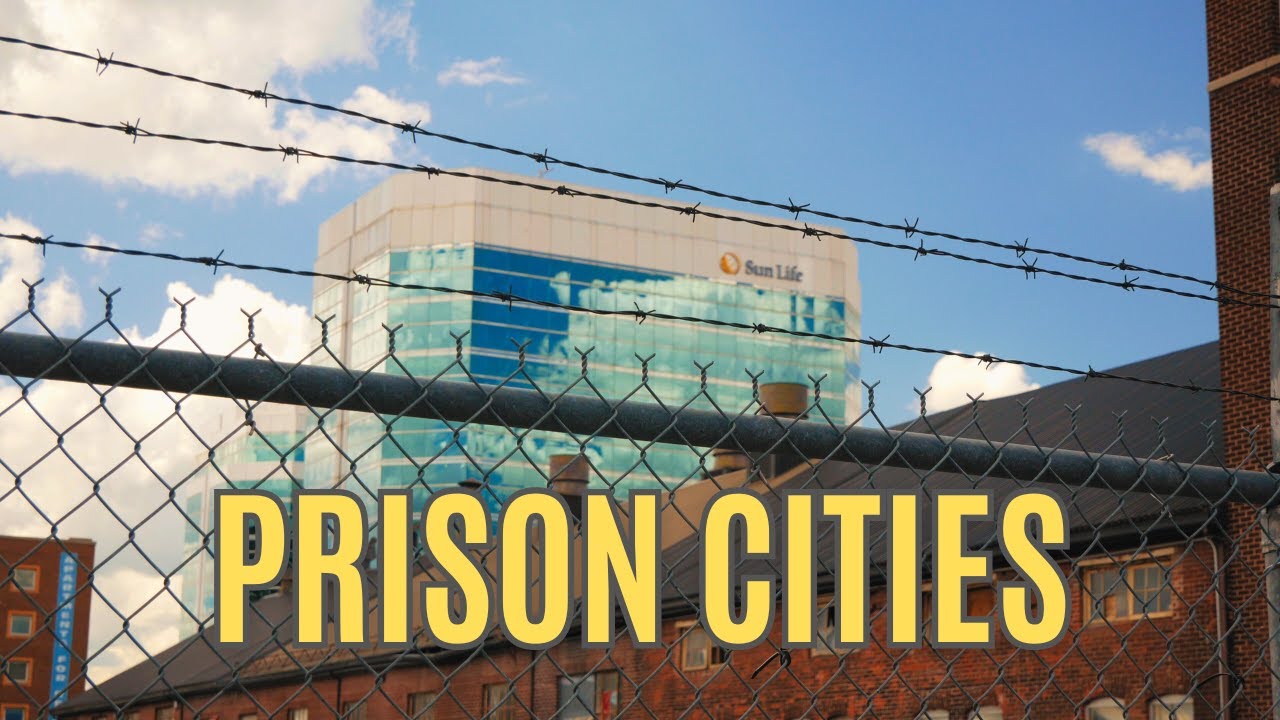Un article sur le sujet de Bloomberg.
On donne l’exemple de Paris (c’était une promesse d’Anne Hildago lors des dernières élections municipales). Il y a aussi l’exemple de Barcelone, Melbourne, Detroit et Portland.
The 15-Minute City—No Cars Required—Is Urban Planning’s New Utopia
From Paris to Portland, cities are attempting to give residents everything they need within a few minutes of their front doors. Can it work—without leaving anyone out?
By Feargus O’Sullivan and Laura Bliss
November 12, 2020, 7:00 AM EST
The Minimes barracks in Paris don’t look like the future of cities. A staid brick-and-limestone complex established in 1925 along a backstreet in the Marais district, it’s the sort of structure you pass without a second glance in a place as photogenic as Paris.
A closer look at its courtyard, however, reveals a striking transformation. The barracks’ former parking lot has become a public garden planted with saplings. The surrounding buildings have been converted to 70 unusually attractive public housing apartments, at a cost of €12.3 million ($14.5 million). Elsewhere in the revamped complex are offices, a day-care facility, artisan workshops, a clinic, and a cafe staffed by people with autism.
The green, mixed-use, community-friendly approach extends to the streets beyond. Five minutes down the road, the vast Place de la Bastille has been renovated as part of a city-funded €30 million revamp of seven major squares. No longer a roaring island of traffic, it’s now dedicated mainly to pedestrians, with rows of trees where asphalt once lay. A stream of bikes runs through the square along a freshly repaved, protected “coronapiste”—one of the bike freeways introduced to make cycling across Greater Paris easier during the coronavirus pandemic. City Hall has since announced that the lanes will be permanent, backed by €300 million in ongoing funding from the region and top-ups from municipalities and the French government.
Place de la Nation, one of seven transformed squares.
PHOTOGRAPHER: DMITRY KOSTYUKOV FOR BLOOMBERG BUSINESSWEEK
Taken together, the new trees and cycleways, community facilities and social housing, homes and workplaces all reflect a potentially transformative vision for urban planners: the 15-minute city. “The 15-minute city represents the possibility of a decentralized city,” says Carlos Moreno, a scientific director and professor specializing in complex systems and innovation at University of Paris 1. “At its heart is the concept of mixing urban social functions to create a vibrant vicinity”—replicated, like fractals, across an entire urban expanse.
Named Paris Mayor Anne Hidalgo’s special envoy for smart cities, Moreno has become a kind of deputy philosopher at City Hall as it endeavors to turn the French capital into what he calls a “city of proximities.” His 15-minute concept was developed primarily to reduce urban carbon emissions, reimagining our towns not as divided into discrete zones for living, working, and entertainment, but as mosaics of neighborhoods in which almost all residents’ needs can be met within 15 minutes of their homes on foot, by bike, or on public transit. As workplaces, stores, and homes are brought into closer proximity, street space previously dedicated to cars is freed up, eliminating pollution and making way for gardens, bike lanes, and sports and leisure facilities. All of this allows residents to bring their daily activities out of their homes (which in Paris tend to be small) and into welcoming, safe streets and squares.
Similar ideas have been around for a long time, including in Paris itself. Walkable neighborhoods and villages were the norm long before automobiles and zoning codes spread out and divided up cities in the 20th century. Yet the 15-minute city represents a major departure from the recent past, and in a growing number of other cities it’s become a powerful brand for planners and politicians desperate to sell residents on a carbon-lite existence. Leaders in Barcelona, Detroit, London, Melbourne, Milan, and Portland, Ore., are all working toward similar visions. They’ve been further emboldened by the pandemic, with global mayors touting the model in a July report from the C40 Cities Climate Leadership Group as central to their recovery road maps.
With climate change, Covid-19, and political upheaval all challenging the ideals of globalism, the hope is to refashion cities as places primarily for people to walk, bike, and linger in, rather than commute to. The 15-minute city calls for a return to a more local and somewhat slower way of life, where commuting time is instead invested in richer relationships with what’s nearby. “These crises show us the possibility for rediscovering proximity,” Moreno says. “Because we now have the possibility to stay closer to home, people have rediscovered useful time—another pace for living.”
It’s a utopian vision in an era of deep social distress—but one that might, if carried out piecemeal, without an eye to equality, exacerbate existing inequities. Skeptics also wonder whether a city that’s no longer organized around getting to work is really a city at all.
Dreams of breaking down the segmented urban planning that dominated the 20th century—with industry on the outskirts, residential areas ringing the city, commerce in the core, and auto networks connecting long distances—of course aren’t new. Urban thinkers have been advocating for the preservation or return of walkable, socially mixed neighborhoods at least since the 1961 publication of Jane Jacobs’s paean to Manhattan’s Greenwich Village in The Death and Life of Great American Cities.
This advocacy has slowly filtered into mainstream planning orthodoxy. Copenhagen pedestrianized its main shopping street in 1962, the first of many densely built European cities to take this approach in their downtown cores. In the U.S., the so-called New Urbanism of the 1980s and ’90s created a planning template (first fully realized in Seaside, Fla.) that saw a preference for row houses and apartments over detached houses, as well as for walkable, tree-lined streets and a careful dispersal of schools, stores, and parks to reduce the need to drive. Since the turn of the millennium, rising concerns over air pollution and climate change have led to further innovations, such as the congestion charge London introduced in 2003 for cars driving into the center and massive expansions of public transit networks in cities from Moscow to Medellín.
The 15-minute city concept draws all these trends into an intuitive rubric that ordinary residents can test against their own experiences. It’s also served as a response to pressures wrought by property speculation and rising tourism, which have pushed up rents and driven residents and businesses out of some long-standing communities. The 15-minute city seeks to protect the vitality that made diverse, locally oriented neighborhoods attractive in the first place.
Paris has been moving in this direction for some time. Under the mayorship of the Socialist Party’s Hidalgo, who was first elected in March 2014, the city introduced bans on the most polluting motor vehicles, transformed busy roads flanking the Seine into a linear park, and, in a bid to maintain socially mixed communities, expanded the city’s network of public housing into wealthier areas. It wasn’t until 2020, however, that Hidalgo grouped these efforts together under the umbrella of the 15-minute city, plucking the term from the academic realm and giving it new political urgency.
Moreno
PHOTOGRAPHER: CHAIRE ETI
During her reelection campaign, she teamed with the concept’s originator, Moreno, a former robotics specialist who’d realized that his primary interest was the environment in which robots functioned. Hidalgo had already laid much of the political groundwork for Moreno’s blueprint in her first term; now she could link all those bike paths and car lane closures with a vision that matched the vibrancy and convenience of a metropolis with the ease and greenery of a village.
Since winning reelection in June, she’s doubled down, appointing a Commissioner for the 15-Minute City, Carine Rolland. A Socialist Party councillor who’d previously served in a culture-oriented role in the 18th arrondissement, Rolland also became Paris’s culture commissioner. “It’s true that Paris is already a 15-minute city to an extent,” she says, “but not at the same level in all neighborhoods and not to all sections of the public.” There’s much to be done in the working-class districts on Paris’s eastern edge and in many quarters close to the Boulevard Périphérique beltway, for example. In areas like these, social housing towers frequently predominate, and grocery stores and community facilities such as sports centers and clinics are sparse. This has particularly acute consequences for older people and those with limited mobility, Rolland points out.
Closer to Paris’s heart, she says, are areas “characterized by what we call ‘mono-activity’—a single commercial activity occupying a whole street.” These are notably around the eastern section of the city’s inner ring of boulevards, which are dominated by offices and small shops, leaving streets that are lively on workdays to become quiet and uninviting on evenings and weekends.
Rolland’s job as 15-minute-city commissioner entails coordinating related efforts by different departments. In September, for example, 10 Parisian school grounds reopened as green “oasis yards,” bringing the total to 41 since the initiative began in 2018. Each has been planted with trees and remodeled with soft, rain-absorbent surfaces that will help battle the summer heat. The yards are left available after school for use as public gardens or sports grounds, and they open onto revamped “school streets” where cars are banned or severely limited and where trees and benches have been added. Transformations like these, Rolland explains, involve bringing together departments responsible for education, sports, roads, and parks, as well as local business and community organizations.
Paris is far from alone in attempting this sort of transformation. London’s new “Mini-Hollands” import Dutch planning ideas that seek to reduce or block car access to neighborhood shopping hubs. Barcelona has been turning 400-by-400-meter chunks of road in areas dominated by apartment towers into mostly car-free “superblocks.” Madrid has declared plans to copy that approach, in keeping with its goal to be a “city of 15 minutes” as it recovers from the pandemic. Milan has said the same, with hopes to turn Covid-19 bike lanes and sidewalks permanent as its economy restabilizes. But turning the 15-minute city into a truly global movement will require a big battle over a core urban tension: the primacy of the car.
It’s one thing to turn a Paris or a Barcelona—cities that were almost completely shaped before the automobile was invented—into a neighborhood-centric utopia. Transforming them is rather like giving a supermodel a makeover. The challenge is far greater in the kinds of younger, sprawling cities found in North America or Australia, where cars remain the dominant form of transit.
Some are trying. Since 2017, Melbourne has been working on a long-term planning blueprint centered on the “20-minute neighbourhood.” But while the city’s aspirations are similar to Paris’s, the issues involved in implementing them could scarcely be more different, especially in areas beyond the already densifying core and inner suburbs. “Some middle suburbs are well-served by public transport and are starting to experience densification, but others aren’t on the bandwagon,” explains Roz Hansen, an urbanist who oversaw the preparation of Melbourne’s blueprint. “Meanwhile, the outer suburbs are still at very low densities, partly because of poor public-transport connections.”
The city has tried to improve transportation and job options in the outer suburbs, which are marked by single-family homes. Some of the middle suburbs have hosted pilot projects where new mixed commercial-residential developments are being encouraged and streets are being remodeled to increase cycling space and improve walkability. But to create and connect true 20-minute neighborhoods, investment in public transit will be key. “The bureaucrats kept thinking, ‘Oh, this is also about getting in your car for a 20-minute trip,’ but it’s got nothing to do with the car,” Hansen says. “The 20-minute neighborhood is about active modes of transport and increasing an area’s catchment of accessibility. If you’re walking, 1 to 2 kilometers [1.2 miles] is your catchment. If you’re cycling, it could be up to 5 to 7 kilometers. With public transport, it can be 10 to 15 kilometers.”
“Of course we need to adapt this concept for different realities. Not all people have the possibility of having jobs within 15 minutes”
U.S. cities holding similarly optimistic blueprints are also struggling to strike a balance between vision and reality. In 2016, Detroit Mayor Mike Duggan laid out a plan to turn high-density corridors outside the central business district in his sprawling, 140-square-mile city into 20-minute neighborhoods. Its leading edge thus far is a $17 million pedestrian upgrade in the Livernois-McNichols area, 9 miles northeast of downtown. The project concluded in early 2020 with an emphasis on narrower streets, wider sidewalks for cafe seating, and new lighting. Residents and business owners have been largely pleased with the improvements; a walk to the supermarket is now a much more pleasant ambition.
But that basic urban function is out of reach for the vast majority of the city. An estimated 30,000 citizens lack access to a full-service grocery store, according to a 2017 report by the Detroit Food Policy Council. Katy Trudeau, the city’s deputy director of planning and development, says it wasn’t long ago that many people had to travel to the suburbs for shopping and other errands. That’s improved overall, and nine other districts have been targeted for upgrades along the lines of the one in Livernois-McNichols. Yet chronic fiscal problems and large swaths of blighted structures left vacant as the city’s population declined have made rapid transformation implausible.
So far, most of Detroit’s achievements under the 20-minute rubric have been modest, including moves toward a comprehensive transportation plan and ongoing investments in lighting and resurfacing. Trudeau also points to a new $50 million public-private affordable housing fund, which seeks to help low-income residents stay in place as property values rise in redeveloping neighborhoods. “These things might seem really basic in Paris, but here we’ve suffered so much in the form of population loss and financial uncertainty in the form of bankruptcy,” she says. “We have to balance these concentrated strategies with citywide strategies that help everyone with their quality of life.” The 20-minute label has served mainly as useful shorthand to communicate the city’s goals with residents and investors. Trudeau hopes initiatives such as the housing fund will ensure that it includes a diverse cross section of the population.
Fifteen Minutes in Three Cities
Within 15 minutes of the + symbol
Data: Remix, U.S. Department of Homeland Security, Portland Bureau of Planning and Sustainability, OpenStreetMap, Google, U.S. Department of Agriculture
Detroit’s plans were partly inspired by Portland, Ore., which is celebrated in urbanist circles as a model of U.S. city planning. Portland has the highest rate of bike commuting of any major American metro, a tight boundary that defines how much it can sprawl, and forward-thinking policies aimed at spurring dense, lower-cost housing production. “We’re often mixed up with Paris,” jokes Chris Warner, director of the Portland Bureau of Transportation (PBOT).
Yet even there, it will take years to achieve the level of compactness that makes for a “complete neighborhood,” as the city’s 2013 plan phrased its goal. About three-quarters of Portland’s residential land is occupied primarily by single-family homes, and more than half of its population commutes by car. A recent Brookings Institution report that studied local travel behaviors found that among six U.S. metropolitan areas, Portland had the shortest average trip distance for people traveling to work, shopping, and errands. But that distance was still 6.2 miles, hardly a 15-minute walk or bike ride to the dentist or laundromat. To combat this, PBOT is spending most of its $150 million capital-improvement budget on bike and walking infrastructure inside complete neighborhoods, and on transit to connect them.
Adie Tomer, a fellow at Brookings’ Metropolitan Policy Program and co-author of the report, says the 15-minute concept falls flat in America because “people in the U.S. already live in a 15-minute city, it’s just that they’re covering vast distances in a car.” Planners concerned with urban livability and rising carbon emissions might do well to focus on distance rather than time, he says. He suggests that the “3-mile city” might resonate better.
However the concept is cast, Art Pearce, PBOT’s manager of policy planning and projects, sees signs that Portlanders are keeping their travel closer to home as the pandemic changes the way they relate to their surroundings. “We’re seeing a lot of people adjusting their behaviors to focus more on their communities,” he says. “That produces an opportunity to strengthen those ties as people return to a more normal life.”
One thing would-be 15-minute cities everywhere will have to reckon with is social equity—and affordable housing in particular, as Detroit’s Trudeau points out. Many neighborhood services rely on lower-income workers who often make long commutes, and a 15-minute city isn’t really one if only the well-off can stay put. To that end, Paris aspires to have 30% of its housing stock in the public domain by 2030, and it’s been increasing the share even in richer districts despite resistance from well-heeled neighbors. “It is completely part of Anne Hidalgo’s program to resist real estate pressure, to maintain public housing, and to diversify the housing offer for the middle class,” says Rolland, the 15-minute-city commissioner.
Cyclists along Rue de Rivoli in Paris.
PHOTOGRAPHER: DMITRY KOSTYUKOV FOR BLOOMBERG BUSINESSWEEK
Such measures can, to a degree, counterbalance Paris’s trends toward high rents and social polarization. But in a city where property prices rose even during the pandemic, they’re unlikely to prevail completely. And other goals of the 15-minute city, such as greening and pedestrianizing the heart of Paris, risk alienating lower-income suburban commuters. This accusation was leveled against Hidalgo’s administration in 2016, after it introduced changes to the Seine’s lower quayside that eliminated a key route for car commuters. Valérie Pécresse, president of the regional council for Île-de-France, which encompasses Paris’s suburbs, accused Hidalgo of acting in an “egotistical manner” by pushing through road closures, noting that “some people don’t have any solution other than driving into Paris for work, because they don’t have the means to live there.” Others have pointed out a related concern: that, by prioritizing local infrastructure, governments will overlook badly needed regional investments, such as in transit systems for more distant commuters.
Moreno recognizes that large segments of the population might never enjoy the slower-paced, localized life he envisions. “Of course we need to adapt this concept for different realities,” he says. “Not all people have the possibility of having jobs within 15 minutes.” But he emphasizes that many people’s circumstances could be profoundly changed—something he believes we’re already seeing because of the pandemic’s canceled commutes. In his view, centralized corporate offices are a thing of the past; telework and constellations of coworking hubs are the future.
The 15-minute city could also be seen as what writer Dan Hill identified as a form of “post-traumatic urbanism”—a way to recover from the onslaughts of such things as property speculation, overtourism, and now the pandemic. Already it’s become clear in Paris, Rolland says, that the city needs a more localized medical network, “so people don’t feel they have to go straight to the emergency room.”
Following the unending traumas of 2020, there’s an appealing nostalgia to a renewed emphasis on neighborhoods, even if it addresses only some of the city’s modern challenges. This, too, Moreno acknowledges, pointing yet again to his idea’s recuperative possibilities above all. “The 15-minute city is a journey, a guideline, a possibility for transforming the paradigm for how we live over the next many decades,” he says. “Before, people were losing useful time. With the 15-minute city, we want them to regain it.”
Une ville du quart d’heure en banlieue de Salt Lake City (Via Bloomberg CityLab)
Utah’s Walkable ‘15-Minute City’ Could Still Leave Lots of Room for Cars
A planned community set to rise in a suburb near Salt Lake City could feature a network of shared mobility hubs and walking trails — plus tens of thousands of parking spots.
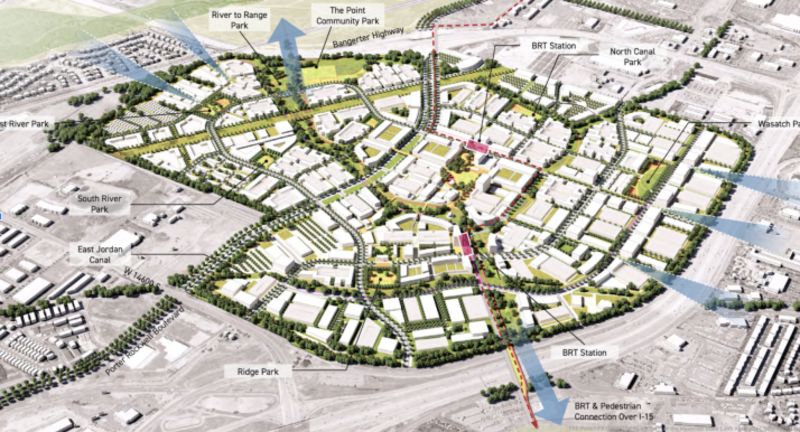
Billed as a ‘15-minute city,’ The Point is envisioned as a walkable community, but motor vehicles still play a big role.
Credit: The Point of the Mountain State Land Authority
By Laura Bliss
March 21, 2022, 12:37 PM EDTUpdated onMarch 21, 2022, 5:42 PM EDT
The developers of “The Point,” a master-planned community set to rise in a Utah suburb between Salt Lake City and Provo, envision their project as a “15-minute city”: Plans describe a live-work community with some 7,400 residential units and at least 30,000 jobs, all located just a short walk from schools, workplaces, retail, restaurants and recreation.
Unlike some other recent proposals for “zero-driving” developments, however, The Point promises to be a place for cars, too.
“It’s not that no one has a car,” said Peter Kindel, an urban design and planning principal at Skidmore, Owings & Merrill who helped create the framework plan for the site that project overseers approved last year. “We’re suggesting it’s more than possible to live with one car to make that big-box [store] trip or go skiing. But for families and young people that are going to be part of the community, they won’t need that on a day-to-day basis.”
The development, which is being led by the government-appointed Point of the Mountain State Land Authority, will sit on about 600 acres of state-owned land that’s currently occupied by the Utah State Prison. According to a new transportation study developed for the site, residents would move around on walking trails and bikeways, augmented by various shared mobility options. But the original framework plan also identifies more than 40,800 parking spaces — to be housed mainly inside buildings, out of view — for the 13,000 residents and 31,000 office workers projected to populate the area.
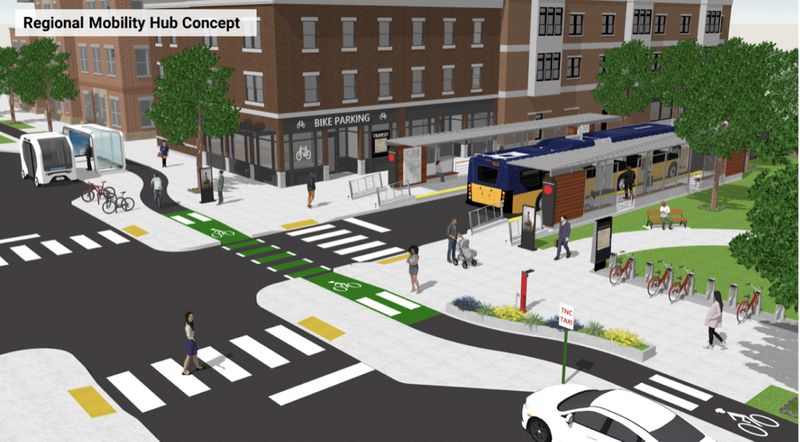
Multimodal transit hubs like the one shown in this concept illustration could connect Point residents to bus rapid transit, scooters, shared vehicles and EV-charging.
Credit: The Point of the Mountain State Land Authority
The 40,000 parking spaces planned is roughly what would be required in a typical community — a figure that reflects the challenges in establishing a built-from-scratch 15-minute city inside a car-centric American suburb. The prison opened in 1951 on what was rural land in the city of Draper, about 20 miles from Salt Lake City; since then, the once-sleepy town has been transformed into a desirable bedroom community for commuters along the busy I-15 corridor.
The transportation study, which was presented to the board earlier this month, highlights a range of mobility offerings that would support “one-car” living conditions. Led by the transportation planning consultancy Sam Schwartz, the report proposes a mix of future-forward and old-school options for moving residents and visitors. Inside the development, a dense network of on-street bikeways and off-street walking trails would link to a planned commercial core. A series of mobility hubs, similar to those seen in Pittsburgh, would offer shared scooters, car-sharing vehicles, electric-vehicle charging and other amenities clustered in the same locations. Fare payment, directions and scheduling would be accessed on a smartphone app.
To help commuters and other visitors access the community, a high-frequency shuttle route would conduct travelers to a bus-rapid transit station that will connect to other regional transit lines. The circulator could eventually be operated autonomously, as a way to save on driver costs and showcase AV technology.
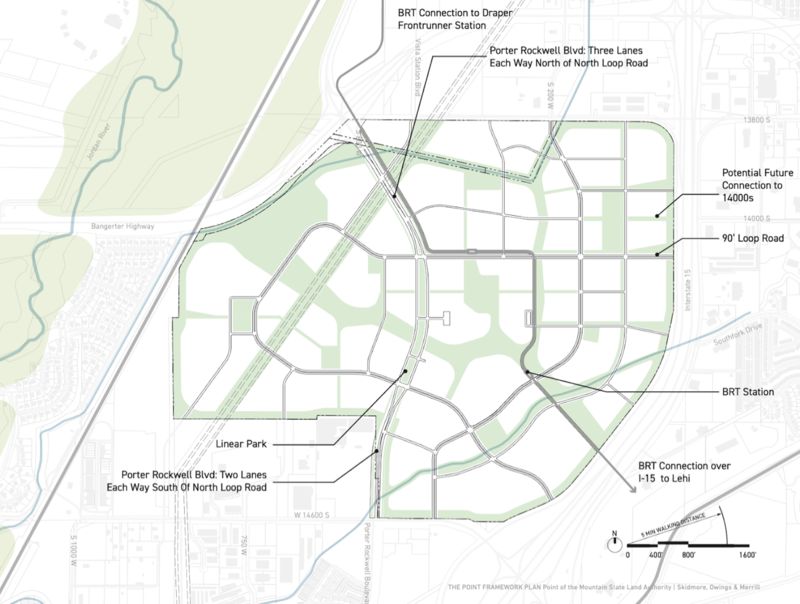
A network of walking and biking trails promises to connect residents to a commercial core within a few minutes.
Credit: The Point of the Mountain State Land Authority
In contrast with other recent master-planned neighborhoods, such as Sidewalk Labs’ canceled Quayside project in Toronto, digital tools and trappings are meant to be integrated in service of residents’ daily needs, not as the centerpiece of their lives.
“In terms of the technologies we wanted to focus on, it was about understanding the types of trips people would need to take, and thinking through what types of options would serve them,” said Alex Hanson, an associate at Sam Schwartz who worked on the mobility report. “But not others that don’t address those immediate challenges.”
Alan Matheson, the executive director of the Point of the Mountain State Land Authority, said the hope is for a range of income levels to reside at the Point — including people who work in technology and academia, as well as those who hold service jobs on site — and that a mix of housing types will reflect that.
Cities are changing fast. Keep up with the CityLab Daily newsletter.The best way to follow issues you care about
The mobility study is still in draft form, and the costs and benefits of its recommendations will take time to be weighed by board members, Matheson said. The state land authority is currently in the process of selecting development partners to build the project; meanwhile, inmates from the state prison complex are set to move later this year to a new facility outside Salt Lake City International Airport. Site preparations for The Point will then begin, with infrastructure starting to go in as soon as 2023.
If The Point is built with the number of spaces contemplated in its framework plan, that could make it hard for the project to achieve its goals of being a car-light community. Reducing parking — particularly free parking — is key to changing travel behavior, said Jennifer Dill, an urban planning professor and director of the Transportation Research and Education Center at Portland State University. “The evidence is really clear on this,” she said. “You have to get the parking right at the beginning.”
The hope is that the strategies outlined in the mobility study and the compactness of the site will end up cutting down the number of parking spaces that are ultimately built by approximately half, according to project leaders. But market viability dictates a certain amount of room for cars, Matheson said.
“The goal of all involved is to see if we can reduce those parking stalls, not only to discourage single-occupancy vehicle use but also to save money,” he said. “We want to push the envelope, but we also need to be practical.”
(Updates project parking-space targets in paragraph 13.)
La Ville de Montréal est membre du C40
A Global Push for More ‘15-Minute Cities’
To combat climate change, the nonprofit group C40 Cities is partnering with a Danish firm to pilot walkable neighborhoods in five global cities.
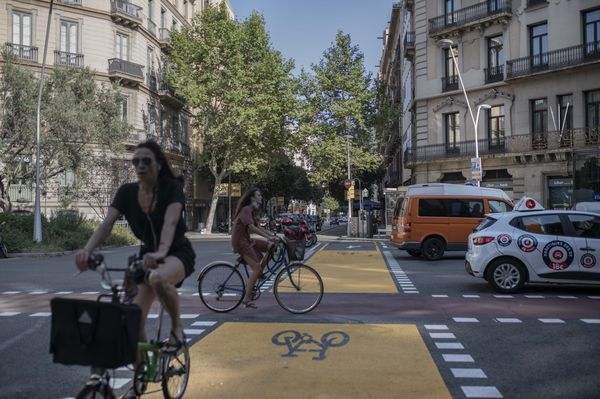
Cyclists use bike lanes in Barcelona in 2020. The pandemic sharpened the global appetite for more walkable and bike-able neighborhoods.
Photographer: Maria Contreras Coll/Bloomberg
By Amelia Pollard
September 21, 2022 at 6:06 PM EDT
The C40 Cities Climate Leadership Group, a network of about 100 global mayors that focuses on climate change and sustainability, is partnering with alternative asset manager Nordic Real Estate Partners (NREP) to bring one of the buzziest concepts in urban planning — the “15-minute city” — to life in a handful of locations globally.
The idea is to make urban areas less dependent on cars as part of the fight against climate change. The 15-minute city framework emphasizes bringing the essentials of daily life — work, entertainment, schools and green space — within a short walk or bicycle ride from home, reducing vehicle use and dramatically cutting carbon and pollution emissions.
The public-private partnership will start with at least five pilot cities, which have yet to be announced, according to a press conference Wednesday at the Earthshot Summit in New York City, which was co-sponsored by Bloomberg Philanthropies.
(Disclaimer: Bloomberg Philanthropies is the philanthropic organization of Michael Bloomberg, the founder and majority owner of Bloomberg LP, which owns Bloomberg News; Michael Bloomberg is also the president of the board of C40 Cities.)
The initiative will focus on two types of neighborhoods: new ones cropping up and existing ones that need revamping. NREP has pledged an initial commitment of $500,000 to the plan over the course of two years. The Copenhagen-based firm oversees 18 billion euros ($17.7 billion) in assets under management.
“Dense, multi-purpose neighborhoods see a reduction in emissions,” Mark Watts, the executive director of C40, said during the press conference. The concept “reclaims space in cities from polluting vehicles back to people.”
According to the Intergovernmental Panel on Climate Change, locating jobs and homes in close proximity to one another and providing good public transportation and mixed land use can help cut emissions by around 25%.
The 15-minute city concept has been most closely associated with Paris, where Carlos Moreno, scientific director of Sorbonne University’s ETI Lab, has promoted it in his role as an adviser to Mayor Anne Hidalgo. But the idea gained international visibility during the Covid-19 pandemic as lockdowns forced millions to remain closer to home. Developers and planners have adopted the label for a master-planned community in a Utah suburb; a Swedish think tank, meanwhile, has proposed a hyper-local “one-minute city.”
Moreno is also a strategic partner in the C40/NREP initiative, as is UN-Habitat. Organizers say the pilot programs will be one of the first attempts to coordinate efforts to create 15-minute neighborhoods between local officials around the world, with the goal of establishing design standards and blueprints that other cities can follow. To be sure, local input will play a crucial role.
“The invisible partner in all of this is, of course, city governments,” said Watts.
Conspiracy Theorists Think Walkable Cities Are Really Open-Air Prison Dystopias Now
To many city-dwellers, a “15-minute city” with everything you need within walking distance is a dream. Conspiracy theorists are seeing it differently.
IMAGE: ALEXANDER SPATARI VIA GETTY IMAGES
To many urbanites, a short commute and having your grocery shop, favorite bar, and library branch all within walking distance are markers of a higher quality of life. But recent attempts to reduce commute times to 15 minutes and make cities more walkable have led to waves of weird conspiracy theories about an encroaching police state that must be stopped at all costs.
The “15-minute city,” as this design paradigm has been dubbed, is not a city-dweller’s dream in this addled conception, but an open-air surveillance prison nightmare that is being imposed by shadowy forces.
Edmonton, Canada is the latest city getting backlash, including a plannedin-person protest that will have a prominent anti-vaccine conspiracist in attendance. “You will spend 90% of your life in this 15 minute area as they are monitoring your ‘carbon footprint,’” the flyer reads. In January, another protest in the U.K. was held to oppose 15-minute city proposals in Oxford, where participants connected the plan to COVID-19 lockdowns and vague notions of government control.
Read more
The conspiracy theory has been circulating on Twitter, TikTok, and Instagram, stemming from proposals in the U.K. and Canada. Nearly all the videos inject made-up details.
One TikTok out of Canada with 670,000 views compared Edmonton’s proposal to the Hunger Games in a video with the song “Fulsom Prison Blues” playing in the background. Another video in the U.K. by a Gen Z TikToker compared the proposal to Black Mirror and attributed the idea to Tories.
“You’re going to have to apply for a fucking permit to leave your zone,” the TikToker says.
For decades, urbanists have pushed back on the car-centric development of cities that proliferated after the Second World War. Highways were erected, buildings went up at great distances from one another, and urban sprawl became the norm. The effects of these decisions are now being felt: Commuting long distances by car increases carbon emissions, leads to congested streets and, arguably, wastes a lot of time.
The emphasis on walkability in cities has gained traction in recent years. With an emphasis on the time it takes to commute, the 15-minute city idea suggests cities should be reimagined so that most people can get their needs met in a 15-minute walk or bike ride. The term was coined by Franco-Canadian urbanist Carlos Morenoin 2016. In a 2020 TED video, Moreno said that because of urban sprawl, “our sense of time is warped” as we adjust to the long commutes of car-concentric cities. Moreno was in turn inspired by American urbanist Jane Jacobs, who is the reason many contemporary urbanists in the U.S. praise walkability in urban planning.
In 2020, Paris adopted the term, prompted in part by the urgency of COVID-19 restrictions. To Paris Mayor Anne Hidalgo, it was a way of branding a set of pedestrian-centered redesigns, including street closures and the expansion of bike lanes, actions that mayors in the U.S. also took during the pandemic. Such plans tend to be popular over time but can invite blowback in the short-term. Until recently, that opposition has come from the expected groups: people who enjoy driving, hate parking spaces being taken away, or who fear that denser urban areas will put them in touch with the working class.
But in the last few months, an even more bizarre strain of opposition has been flourishing on TikTok, Instagram and Twitter: conspiracy theorists who believe that 15-minute cities will be pretext for open-air prisons enforced by a police state, where citizens will be prevented from leaving their enclosed zone.
To reduce carbon emissions and respond to the greater number of people working from home, Edmonton Mayor Amarjeet Sohi proposed creating “15-minute districts” by, in Sohi’s words, “widening sidewalks or multi-use trails that encourage walking, or sustainable infrastructure in communities where they make sense,” according to Western Standard. The city first proposed the plan in 2021, suggesting that city planners would focus on neighborhood-level planning that intermixes commercial and residential uses, in an effort to reduce commute times and widen the variety of services and amenities available in residents’ immediate areas.
While residents are right to openly debate the details, the overall strategy seems more realistic than putting the genie of remote work back in the bottle by forcing people to commute to commercial downtowns again, as some cities are trying.
In response to Sohi’s plan, conspiracy theorists began circulating a map purportedly of Edmonton, color-coded into separate neighborhoods, with a text box saying that vehicles will not be permitted to drive between zones. Except the map was actually of Canterbury, England, which had rolled out its own 15-minute city proposal. Edmonton has made no proposal to hinder travel between neighborhoods, and its plans are mainly focused around ensuring neighborhoods have a healthy mix of businesses and services available.
Canterbury’s plan involves closing off traffic on roads through the city’s center to reduce congestion through the use of license-plate readers that will fine motorists, which it calls “traffic filters.” Taxis, delivery vehicles, bikes and pedestrians would still be able to use the roads. Drivers can still cross into different neighborhoods, but it would take a little longer, possibly prompting them to walk or bike instead. Of course, many cities have various schemes to limit car use as traffic congestion has increased—Colombia’s famous pico y placa (peak and plate) rules ban cars from driving certain days of the week based on the digits on their license plates.
But conspiracy theorists saw something more sinister in the proposals, even expressing alarm that the 15-minute city concept has been discussed and promoted by the World Economic Forum, which is already at the center of conspiracy theories around its COVID recovery framework, the Great Reset. Sinister intimations were already percolating when they were boosted by Canadian psychologist Jordan Peterson, who retweeted a tweet containing 15-minute city maps and the caption “It’s already happening…” and the hashtags #GreatReset and #JailSchwab, referring to WEF chairman Klaus Schwab.
“The idea that neighborhoods should be walkable is lovely. The idea that idiot tyrannical bureaucrats can decide by fiat where you’re ‘allowed’ to drive is perhaps the worst imaginable perversion of that idea–and, make no mistake, it’s part of a well-documented plan,” Peterson wrote.
After receiving its own share of misinformation—including from former Independence Party leader Nigel Farage, who called the Canterbury plan a “climate lockdown”—leaders in the Oxfordshire County Council in the U.K. had to put out a statement and video to fact-check claims about the proposal. In the video, Councillor Liz Leffman said they were receiving panicked calls from residents fearing that they would be locked in their own homes. Councilors said the traffic filters would be rolled out in six trial locations in 2024. That video was in turn critiqued on TikTok with sinister music playing in the background.
While the proposals are different in every city, in no place would people be barred from entering a different neighborhood by automobile or any other method. People driving cars on roads that have been closed in the U.K. can get exemptions, but even without an exemption, they can just use another road. Another video suggests that the idea will lead to “invisible barriers” and the government tracking carbon footprints for individuals, so that people will not be allowed to eat beef if they drive too far. Needless to say, this is not being planned. License plate readers have their fair share of problems, but Edmonton has not said they will be fining or ticketing people.
The overall goal of providing people with local options for buying groceries or taking a walk is a good one; unfortunately, however, car culture is so deeply-ingrained that even the suggestion of limiting automobile use results in some dark and imaginative paranoia.
Non, les « villes 15 minutes » ne limiteront pas la liberté de mouvement
Le concept, qui vise à mieux organiser l’espace urbain pour faciliter l’accès aux services essentiels et réduire la dépendance à la voiture, est devenu la cible de théories du complot sur les réseaux sociaux.
Cette vidéo d’une Québécoise qui présente les villes 15 minutes comme des « prisons invisibles » a été vue plus de 330 000 fois sur TikTok. | PHOTO : CAPTURE D’ÉCRAN
Radio-Canada | Nicholas De Rosa | 22 février 2023 | Publié à 14 h 39
Si l’idée d’un quartier où l’on peut accéder à tous les services dont on a besoin dans un rayon de 15 minutes à pied ou à vélo fait rêver de nombreux citoyens, elle relève plutôt du cauchemar dystopique pour de nombreux internautes, qui craignent sans fondement que les « villes 15 minutes » fassent partie d’un plan machiavélique de restriction de la liberté de mouvement et de contrôle de la population.
Le concept des villes du quart d’heure n’est pas nouveau. Il a d’abord été imaginé en 2016 (Nouvelle fenêtre) par l’équipe de recherche de l’urbaniste franco-colombien Carlos Moreno avant d’être adopté par des villes comme Paris (Nouvelle fenêtre) , Melbourne (Nouvelle fenêtre) et Montréal (Nouvelle fenêtre) . D’autres villes canadiennes, dont Ottawa (Nouvelle fenêtre) et Edmonton (Nouvelle fenêtre) , préconisent aussi cette approche.
« Ce n’est pas nécessairement une innovation, c’est juste de mettre en mots des choses que l’on vit déjà dans beaucoup d’endroits dans le monde. On pourrait même utiliser l’expression “quartier complet” », commente le directeur de l’École d’urbanisme et d’architecture de paysage de l’Université de Montréal, Jean-Philippe Meloche.
« L’idée, c’est de s’assurer que les gens puissent avoir toutes les nécessités de la vie à une distance raisonnable à pied ou à vélo. L’objectif qui est derrière ça, c’est de limiter la dépendance à l’automobile et d’améliorer la qualité de vie sans automobile », ajoute le professeur.
« Ils veulent nous confiner »
Sur TikTok, nombreuses sont les vidéos qui décrivent la ville 15 minutes comme un enclos fait de zones prédéfinies hors desquelles les résidents n’auront plus le droit de sortir. Une de ces vidéos, mise en ligne la semaine dernière par une internaute québécoise, a d’ailleurs recueilli plus de 330 000 visionnements.
« Ils veulent nous confiner pour les changements climatiques », dit celle qui s’identifie comme naturopathe dans la vidéo. « Tout le monde va avoir un genre de district, comme dans Hunger Games. Tu vas devoir vivre dans une portion de ta ville et tu ne vas pas pouvoir sortir à plus de 15 minutes », poursuit-elle.
Bien que la lutte contre les changements climatiques soit au cœur du concept de la ville 15 minutes, les « confinements climatiques » et les restrictions à la liberté de mouvement n’en font pas partie.
« C’est de la fabulation, résume l’urbaniste derrière l’idée de la ville du quart d’heure », Carlos Moreno, en entrevue avec les Décrypteurs.
« Nous voulons rompre avec la dépendance de la voiture et faire en sorte qu’on rentre dans un mode de vie beaucoup plus durable. Parce que tel que c’est maintenant, le futur des villes n’est pas durable »
— Une citation de Carlos Moreno, urbaniste et professeur à l’Université de la Sorbonne
Selon M. Moreno, contrairement à ce qu’affirment plusieurs internautes, le but de la ville 15 minutes n’est pas d’éradiquer la voiture, mais bien de réduire idéalement son usage au « strict minimum dans les zones plus compactes » des villes.
Jeu du téléphone de l’Angleterre au Canada
La Québécoise derrière la vidéo virale sur TikTok énumère d’autres restrictions de mouvements qu’elle attribue à ce projet de ville 15 minutes et qui sont tout à fait fausses.
« Si tu sors, tu vas avoir un maximum de sorties par année, et ç’a été établi que c’est 100 sorties par année. Puis tu ne vas quand même pas pouvoir t’éloigner d’un certain périmètre. Puis dans plusieurs pays, si jamais tu sors de ce périmètre-là, […] tu dois payer 56 $ pour aller et 56 $ pour revenir », dit-elle dans la vidéo.
Bien qu’elle puisse sembler farfelue, cette idée de tarification ne sort pas de nulle part : la Ville d’Oxford, en Angleterre, prévoit mettre en place un projet pilote très controversé (Nouvelle fenêtre) , nommé « filtre de trafic (Nouvelle fenêtre) », pour réduire le trafic automobile et bonifier les transports collectifs et actifs.
Le projet vise à réduire autant que possible la circulation des véhicules sur six rues d’Oxford à certaines heures de la journée en imposant des amendes de 35 £ – soit un peu plus de 56 $ – à ceux et celles qui y circuleront. Les résidents d’Oxford peuvent toutefois obtenir des permis pour effectuer 100 passages gratuits par année.
Le conseil de ville d’Oxfordshire assure sur son site web (Nouvelle fenêtre) que ces filtres de trafic ne font pas partie du plan de ville 15 minutes d’Oxford. « La raison pour laquelle nous avons proposé ces changements est que, comme le savent tous ceux qui visitent Oxford ou y vivent, la ville connaît des embouteillages depuis des décennies. Cela nuit à la fois à notre économie et à notre environnement et rend le réseau de bus non viable », peut-on y lire.
Cela n’a pas empêché certains opposants au projet d’amalgamer dans leurs discours ville 15 minutes, filtres de trafic et théories du complot (Nouvelle fenêtre) visant le contrôle de la population par les élites. De fausses informations selon lesquelles les filtres de trafic seront des barrières physiques ont également circulé en ligne, selon le conseil de ville d’Oxfordshire.
Ces amalgames et la panique qu’ils ont engendrée en ligne ont même mené à des manifestations anti-ville 15 minutes à Edmonton le 10 février. Un urbaniste de la Ville qui est allé à la rencontre des manifestants pour démystifier le concept a alors été pris à partie (Nouvelle fenêtre) par la figure de proue conspirationniste Chris Sky au sujet de « barrières physiques » qu’entendait supposément installer la Ville pour limiter la liberté de circulation de ses citoyens.
L’urbaniste de la Ville d’Edmonton, Sean Bohle, a été pris à partie par la figure de proue conspirationniste Chris Sky lors d’une manifestation anti-ville 15 minutes. | PHOTO : CAPTURE D’ÉCRAN
Un concept vague et malléable
Depuis 2020, l’idée de la ville 15 minutes est promue par le Cities Climate Leadership Group (Nouvelle fenêtre) , ou C40, un regroupement de maires de villes voulant lutter contre les changements climatiques dont font partie Montréal, Toronto et Vancouver.
Il est important de noter que les villes du C40 ne s’engagent pas à mettre en place des mesures spécifiques en faisant la promotion de la ville du quart d’heure : chaque municipalité peut appliquer le concept à sa sauce, et si l’une d’entre elles décidait par exemple de mettre en place des filtres de trafic, cela ne veut pas dire que les autres suivraient.
« Ce n’est pas une doctrine, ce n’est pas une doxa : c’est un cadre de réflexion urbaine et territoriale qui permet d’aller vers des villes ou des territoires polycentriques », résume Carlos Moreno.
À Montréal, cela pourra par exemple se traduire par la bonification des services de transport en commun, selon Robert Beaudry, l’élu responsable de l’urbanisme au sein du comité exécutif de la Ville.
« La prolongation de la ligne bleue nous donnera l’opportunité de rendre plus compacts des secteurs d’Anjou et de Saint-Léonard et de transformer des espaces de stationnement à ciel ouvert en espaces de développement immobilier », illustre M. Beaudry.
Selon l’élu, les villes 15 minutes permettront aux gens d’avoir davantage de liberté.
« L’objectif, c’est vraiment de donner plus d’options de mobilité. Donc au final, contrairement à ce que dit la vidéo [virale sur TikTok], on veut donner beaucoup plus de liberté aux citoyens », estime-t-il.
Dans un autre ordre d’idée, voici un reportage qui pourrait rassurer les personnes qui pensaient que Montréal est trop congestionné et ne favorise pas la mobilité… ![]()
![]()
“Quand on se regarde, on se désole. Quand on se compare, on se console.” ![]()
Le New York Times a publié un article sur les complotistes et la ville du 15 minute
The 15-Minute City: Where Urban Planning Meets Conspiracy Theories
Is having all of life’s amenities within a 15-minute walk convenient? Or is it a government leash? We explain.
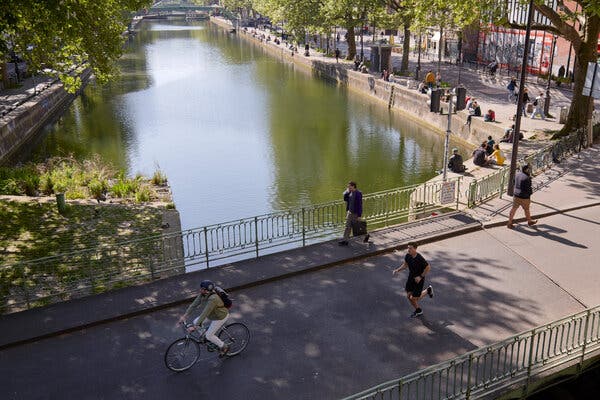
The mayor of Paris has embraced the concept of so-called 15-minute cities, in which residents live near all of their daily needs.
Credit : Pierre Crom/Getty Images
By Chris Stanford
March 1, 2023Updated 9:45 a.m. ET
LONDON — It is an old, seemingly innocuous idea among city planners: The closer you live to your workplace, shops, schools and other amenities, the better your quality of life will be.
But the concept of so-called 15-minute cities, in which life’s necessities are only a short walk or bike ride from home, does not sound utopian to everyone. To some, it sounds like a restriction on the routine act of driving a car. To others, especially on the far right, it sounds like the first step to draconian government lockdowns that will confine people in their homes.
Regardless, it has become a source of widespread confusion, disinformation and conspiracy theories.
A quick history of the 15-minute city.
The idea behind 15-minute cities is not a new one, and is familiar to anyone who has strolled around the historic villages of Europe or remembers bustling Main Streets in the United States before the postwar sprawl that arrived with the Interstate System.
More recently, developments that market themselves as places to live, work and play have helped breathe new life into America’s inner cities. In 2012, Portland, Ore., adopted a plan for “20-minute neighborhoods,” in which residents could live within a half-mile of amenities such as grocery stores, parks and elementary schools.
The concept gained new momentum during the pandemic, which altered both the daily lives of millions of newly cooped-up commuters, as well as ideas about the future of urban design. Proponents say 15-minute cities are healthier for their residents and for the environment, as they encourage walking and discourage a reliance on cars.
Is the idea actually catching on?
So it would seem.
In responding to the challenges posed by the pandemic and climate change, a number of cities around the world have adopted policies inspired by the 15-minute model, aiming to improve their livability and sustainability.
One of the most aggressive efforts has been in Paris, where before the pandemic, the mayor, Anne Hidalgo, effectively declared war on cars in an effort to reduce their planet-warming emissions.
She later made the idea of a 15-minute city a centerpiece of her successful re-election campaign in 2020.
One of her advisers, Carlos Moreno, a French academic, popularized the model of the 15-minute city (or “la ville du quart d’heure”) and outlined three key features during a TED Talk in 2020.
“First, the rhythm of the city should follow humans, not cars,” he said. “Second, each square meter should serve many different purposes. Finally, neighborhoods should be designed so that we can live, work and thrive in them without having to constantly commute elsewhere.”
So why are some people afraid of 15-minute cities?
It’s that first part — a focus on people, rather than cars — that has driven some recent pushback, as 15-minute cities replace Covid lockdowns and mask-wearing as the latest perceived threat to personal freedoms, at least among some people.
Jordan B. Peterson, the psychologist and commentator who is widely critical of the modern left and runs a popular YouTube channel, has warned of “idiot tyrannical bureaucrats” deciding where people can drive and said 15-minute cities “are just another fad hijacked by wannabe authoritarians.”
Last month on Twitter, Mr. Peterson pointed to a report from C40 Cities, a group of 96 cities around the world working to mitigate the effects of climate change, that said “any city where a private vehicle is necessary to get around is likely to be fundamentally unequal.”
The concept of 15-minute cities has also been caught up in broader conspiracy theories about efforts to remake society as the world emerges from the pandemic. The focus of many of those theories is an effort by the World Economic Forum called “The Great Reset.”
That initiative began in 2020, with the help of a cinematic video narrated by the then-Prince of Wales, now King Charles III, who called for “bold and imaginative action” in pursuit of a more equitable and sustainable future.
But the far-reaching, if vague, plan from the group, a nongovernmental organization best known for its annual meeting of business leaders in Davos, Switzerland, soon became fodder for concerns — some more reasonable than others — about an unelected global elite’s using the pandemic to reorder life as we know it.
The Davos group itself later acknowledged in a video that the “Great Reset” branding “hasn’t gone down well” and that it sounded as if it was “masking some nefarious plan for world domination.”
Where the controversy has become real.
The debate over 15-minute cities has been especially pronounced in Britain, where a number of cities, most notably Oxford, have adopted policies that incorporate parts of the idea.
In Parliament last month, Nick Fletcher, a Conservative member who represents part of Yorkshire, in northern England, called for a debate about “the international socialist concept” of 15-minute cities, which, he said, “would take away your personal freedoms.”
Days later, Mark Dolan, a host on GB News, a Fox News-style TV channel that began last year, warned viewers of what he called the “dystopian plan” being pursued by several communities that depends on “a surveillance culture that would make Pyongyang envious.”
In Oxford, a centuries-old university town that has long been bedeviled by traffic congestion, local officials have referred to the 15-minute-city concept as part of their long-term development plans. But the idea has also gotten tangled up in a more immediate dispute over efforts to limit traffic.
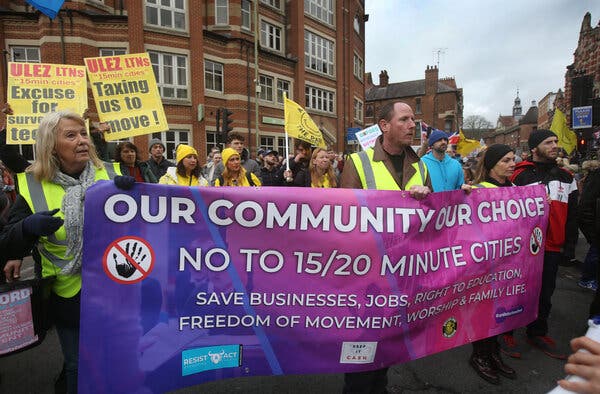
Efforts to limit traffic in Oxford, England, have prompted a backlash in the community, including a protest on Feb. 18.
Credit: Martin Pope/Getty Images
A city’s plan leads to confusion, and disinformation.
Officials in Oxford approved a plan last year to install “traffic filters,” which would limit access on six roads in the city during certain times of day. The filters are cameras, not physical barriers, that take photos of vehicles’ license plates. Fines are then issued to those without a permit.
Officials said the system was intended to reduce traffic and move it out to the “ring road” that encircles the city. But it led to widespread confusion about where drivers could go and when, fed by disinformation online that claimed people would be confined to their neighborhoods, which they would need government permission to leave.
In addition to the traffic filters, some areas in Oxford have been designated “low-traffic neighborhoods,” a system used in cities across Britain in which bollards or other barriers prevent vehicular traffic on certain streets, to the dismay of some drivers and residents.
Within weeks, confusion over the traffic filters prompted no fewer than seven different fact-checking efforts (including by The Associated Press and USA Today), as well as a statement from local officials saying that government employees had been subjected to abuse because of “inaccurate information” about the plan.
“These conspiracy theories are causing real-world harm and need to stop,” Liz Leffman, the leader of the Oxfordshire County Council, said in a video. “We have been receiving many calls and emails from worried residents in genuine fear that they might be locked in their own homes. This is categorically untrue.”
Such reassurances have not quelled the controversy, and thousands of protesters in Oxford rallied against the traffic measures last month, the BBC reported.
Mr. Moreno, who has been a key promoter of the 15-minute city, addressed the disinformation surrounding the concept in a recent interview with The Times of London.
“People can be totally crazy,” he said. “But I am not affected. I will carry on spreading the message to improve the structure of urban life. This insane campaign of hate won’t win.”
Crazy stuff ![]()
The 15-Minute City Freakout Is a Case Study in Conspiracy Paranoia
Far-right protesters in the UK claim that Oxford’s traffic-control plan is a part of a global authoritarian plot. What the heck is going on?
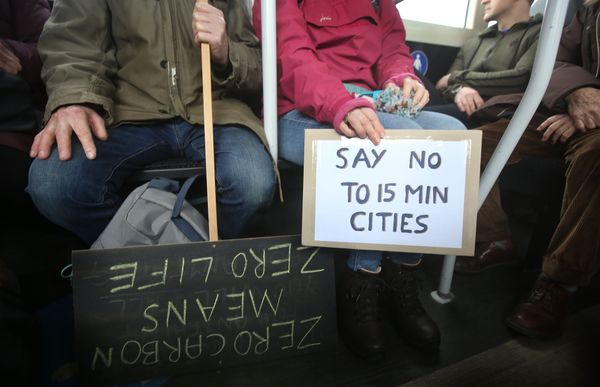
Protesters in Oxford resist the oppressive yoke of walkability on Feb. 18.
Photographer: Martin Pope/Getty Images Europe
By
Feargus O’Sullivan and
Daniel Zuidijk
March 2, 2023 at 1:00 AM EST
It is the year 2049, and residents of the UK city of Oxford are unable to leave their neighborhoods. If they do, a network of cameras — installed years earlier under the guise of easing traffic congestion — track their movements. If they stray too far from their registered addresses, a £100 fine is automatically removed from their bank accounts. The only cars now allowed on the streets belong to representatives of the world government, who relentlessly patrol the city for anyone breaking the rules.
That’s the scenario conjured by adherents of a conspiracy theory that has emerged in Britain, triggered by plans to place restrictions on through-traffic and fed by the popularity of a largely unrelated urban planning concept — the pedestrian-friendly “15-minute city.”
The bizarre speculation burst into the real world on Feb. 18, when an estimated 2,000 demonstrators gathered in central Oxford. Five people were arrested during the demonstration, which drew groups of protesters and counter-protesters to the heart of the university town.
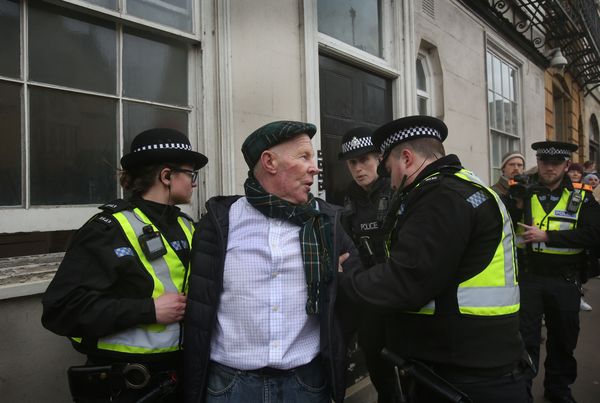
A man is arrested at the demonstration against 15-minute cities in Oxford on Feb. 18.
Photographer: Martin Pope/Getty Images Europe
At issue was the proposed introduction of six new traffic filters intended to limit car use through residential parts of the city at peak hours. Monitored by automatic license plate readers, these filters would fine drivers from outside the county of Oxfordshire who entered central areas during high-traffic periods. Oxford residents will be allowed fine-free peak-hour access for 100 days per year, with residents of the wider county able to apply for a 25-day fine-free access permit.
Such efforts to limit vehicles have become increasingly common in UK cities, and many have faced opposition from drivers and residents. But the Oxford proposal took a weird turn when some protesters described the filters an effort to carve Oxford into six sealed-off “15-minute cities.” That’s a reference to the hyper-local planning model coined by Franco-Colombian professor Carlos Moreno and adopted by mobility advocates, developers and city leaders around the world. Its principle holds that daily needs like workplaces, schools and amenities should ideally be located within a short walk or bike ride from home.
Conflating walkability with a dystopian future of surveillance and oppression takes some work, but in recent weeks the term managed to get sucked into a maelstrom of British conspiracy theories. A British MP called 15-minute cities “an international socialist conspiracy,” while conservative self-help guru Jordan Peterson tweeted Oxford’s vehicle restrictions were the work of “idiot tyrannical bureaucrats” and referred his followers to the “Great Reset,” a 2020 World Economic Forum initiative that’s become a magnet for right-wing fantasies about a Covid-fueled plot to destroy capitalism. A British TV presenter also took up that theme, insisting that the street revamp was part of a push for “one world government.” Afterward, a leading UK Jewish organization and a group of MPs warned the network of indulging in dog-whistle anti-Semitism.
So out of proportion are the claims compared to what Oxford’s traffic-calming plan calls for that it takes some unpacking to explain how it happened.
Early misreporting of the issue helped throw oil on the fire. No local officials promised to divide Oxford into six “15-minute cities,” as some local media accounts implied. While the Oxford City Council does cite Moreno’s concept as a guiding principle for its 2040 local plan, it’s not involved in rethinking the city’s streets. That’s the work of Oxfordshire County Council, a different body that oversees not just Oxford itself but its large surrounding county, an area of just over 1,000 square miles. What the county is proposing — without mentioning the 15-minute city concept — is a street intervention known as a low-traffic neighborhood, or LTN, which has already been implemented widely across Britain.
LTNs date back to the 1970s, with the aim of making urban neighborhoods more walkable and bikeable by restricting car access to residential streets. They are a familiar source of local-level controversy, especially recently, since they proliferated immediately before and during the pandemic. Opponents have said that they slow down emergency services and displace traffic from affluent areas onto major arteries, where poorer residents are more likely to live. But recent research suggests that LTNs cut traffic within their boundaries by almost half without increasing it on boundary roads, while in London the most deprived quartile of residents are more likely to live within an LTN than the least deprived quartile. LTNs continue to be contentious, but support among London residents has been growing: 47% of respondents to a 2021 survey saying they were in favor of them and only 16% against.
Past opposition to LTNs, however, didn’t take the current bizarre conspiratorial tack, nor have the essentially local debates over their implementation been a target for activists from outside the affected area. In Oxford, protesters pounced on the issue as a “lightning rod” for waging a broader culture war, says Milo Comerford, head of counter-extremism policy and research at the Institute for Strategic Dialogue (ISD), a think tank that studies extremist movements.
Their arguments show a peculiar mix of international and homegrown tinfoil hat-ism. “A lot of the conspiracy’s hallmarks are very American, being at its core about a kind of freedom of movement that’s defined by automobile-friendly cities,” Comerford says. “The odd thing is that it doesn’t really make sense in the context of Oxford. Its medieval center has always been pretty pedestrian and cycle-friendly. In fact, the conspiracy has slightly been imposed on Oxford.”
He cites the experience of the pandemic as a critical factor in the protest’s origins. As many people in the UK and beyond genuinely struggled with Covid-19 restrictions and fears of a dangerous-but-invisible force, their anxieties fueled a rich online ecosystem of misinformation. “Covid has been a Pandora’s-box-opening moment,” says Comerford, one that has forged “unlikely coalitions between people who were previously hardened conspiracy theorists and those who were scared in the context of the pandemic and got drawn in.”
A 2021 report from ISD tracked the rise of the “climate lockdown” conspiracy during the Covid crisis, which found broad buy-in among anti-vaccination and far-right groups. Amplified by conservative media outlets in the US and UK and threaded with antagonism for climate action, this narrative holds that Covid-19 was “merely a precursor to future ‘green tyranny,’” the report states, “and that both governments and global elites would curtail civil liberties under the pretext of climate change.”
Accordingly, some Oxford protesters see the town’s car-calming initiative as an extension of a sinister authoritarian agenda. In videos and memes dispersed via social media, their vision of the 15-minute city often references the extreme social confinement enforced in Wuhan and other Chinese cities amid China’s now-discarded Covid Zero policy.
The pandemic provided ready-made “architectures” of protest, Comerford says, “built to respond to any issue of the day. It’s important to know that these episodes are essentially issue-agnostic.”
It’s also important to know that the UK’s wave of 15-minute-city protest employs a very fundamental misunderstanding of the concept.
“We just applied a term to something that has been there all along.”
Many Oxford protesters fixate on the notion that authorities intend to break cities up into small, fenced-off zones within which citizens will be confined by physical barriers, facial recognition tech, or other means. These grimly totalitarian scenarios do indeed sound alarming, but they have nothing to do with the reality of 15-minute-city-style urban thinking.
The term doesn’t describe a discrete area with barriers — it’s a planning approach that tries to ensure that schools, health-care facilities, parks and other amenities are spread equitably across neighborhoods, limiting the need for lengthy commutes and expanding job access. The time span in the name refers simply to what a person can easily reach from their home. Every resident’s 15 minute radius is going to be different; a city of a million homes will have a million overlapping 15-minute cities.
If this idea sounds familiar — or very familiar — that’s because it is. The general concept reflects the dominant direction of urban planning for at least the last 20 years, in which cities have tried to move away from the rigid single-use zoning popular in the earlier 20th century toward a mixed-use template that integrates homes, businesses, cultural venues and workplaces within the same areas. Carlos Moreno didn’t dramatically innovate on this approach; he merely packaged it a very effective way, by placing the ordinary resident at the heart of the urban plan.
That doesn’t mean that the 15-minute cities framework doesn’t raise legitimate concerns. Critics of hyper-local planning policies have highlighted how they might displace less-affluent residents, as seen in Barcelona’s “superblock” system, where through-traffic is restricted to a small part of the city grid to cut pollution and increase car-free public space. Others dismiss the approach as hopelessly utopian for North American cities planned around automobile use, which are not just low density but have social and racial segregation operating at a far more entrenched level than zoning alone can address.
Such concerns, however, are typically voiced by progressive foes of corporate overreach, not the far-right conspiracists who converged on Oxford and saw eco-tyranny on the march because their drive to the grocery store may be slightly extended.
Meanwhile, the leaders of that city, whose central street plan took shape around eight centuries before the automobile’s invention, have been left scrambling to understand the strange forces they unwittingly tapped. “We just applied a term to something that has been there all along,” says Councillor Alex Hollingsworth of the Oxford City Council. That’s the body that first invoked the 15-minute city template for its long-term planning, but didn’t draw the street changes that triggered the current protests.
About the controversy, Hollingsworth sounds understandably bemused. “What is more British,” he asks, “than a corner shop and a pub you can walk to?”
Wow. Je viens de voir les derniers articles publiés ici…
Sous des articles québécois portant sur le tremblement de terre en Turquie et en Syrie, des personnes accusent très sérieusement les Etats-Unis d’avoir provoqué le désastre grâce à une machine inventée par Tesla il y a plus de 100 ans.
Là, l’idée de réduire le temps de transport par de la densité, un environnement sécuritaire et une mixité de services est vue comme une incarcération…
‘15-minute city’ planning is on the rise, experts say. Here’s what to know.
By Kelsey Ables
March 3, 2023 at 11:42 p.m. EST
A bicycle lane on Rivoli street, in Paris, on Feb. 23. (Ludovic Marin/AFP/Getty Images)
For many, living in a city means facing tedious traffic, packed subways and imposing buildings amid the sprawl. But the increasingly popular urban planning concept known as the “15-minute city” has revived the abiding idea that they should operate at human scale, envisioning a city where every resident can reach essential resources by foot, bicycle or public transport within a quarter of an hour.
City officials and urban planners have endorsed the 15-minute city as a way to tackle climate change, while the pandemic drove home the benefits of proximity to amenities and walkable streets, and prompted a “surge of interest” in the concept, according to Zaheer Allam, an urban strategist and fellow at Deakin University in Australia. But some have also made it the subject of baseless claims about governments’ attempts to control mobility.
Tom Logan, a lecturer in civil and natural resources engineering at the University of Canterbury, said the 15-minute city is about flexibility, not restrictions. “The whole point is to give people the option to be able to walk and bike to things that they need and that just frees them up to do lots of other things,” he told The Post.
Here’s what you need to know.
What is a 15-minute city?
The concept places “humans and their well-being as the main purpose of urban organization,” Carlos Moreno, an urbanist and professor at the Sorbonne University in Paris who is credited with coining the term in 2016, wrote in an email. The idea is “to promote sustainability and health by reducing car dependency and increasing physical activity.”
Paris Mayor Anne Hidalgo made the concept the backbone of her successful 2020 reelection campaign. It has also been employed in a variety of forms in cities such as Sydney’s 30-minute city goal and Singapore’s vision of becoming a “45 minute city with 20 minute towns.”
The term is relatively new, but the idea behind it is not. Fifteen-minute cities are “heavily based on attributes that have been used as design flagships in the past, namely accessibility, walkability, density, land use mix and design diversity,” Georgia Pozoukidou, a professor of city planning at the Aristotle University of Thessaloniki, wrote in an email. She points as far back as “garden cities,” proposed by British urban planner Ebenezer Howard in an 1898 book, as an example of the concept’s roots. It also shares the spirit of New Urbanism, which was popularized in the 1990s and prioritizes walkability in neighborhood planning.
The modern 15-minute city relies on citizen participation and envisions places that “enhance social interaction and cultivate a sense of community, safety, pride, and identity,” Pozoukidou said.
Where can I find one?
Dozens of cities around the world have formally and informally embraced elements of the 15-minute city, though its rules are not ironclad. “The concept should be seen as a set of guiding principles that cities can adapt and apply to their specific needs and challenges,” said Allam at Deakin University.
Paris is one of the most frequently cited examples. Hidalgo’s “ville du quart d’heure” — or quarter-hour city — approach has seen roads closed to vehicles to prioritize pedestrians, investment in public transportation, and improvements to bike lanes and bike-sharing programs in an effort to make self-sufficient communities within the arrondissements of the city. In Barcelona, a similar concept called the “superblock” has taken off, while in Copenhagen, the neighborhood of Nordhavnen is aspiring to become a 5-minute city.
Portland, Ore., was an early adopter of the idea. In 2009, the city’s Climate Action Plan set a goal for 90 percent of residents to be able to walk or cycle to meet nonwork needs by 2030. Plan Melbourne, launched in 2017, aims to reimagine the Australian city over the next three decades so residents can “live locally” and reach what they need in a 20-minute round trip. And Shanghai has pitched a similar concept called “15 minute community living circles.”
People on a walk during their lunch break in the Raffles Place financial business district in Singapore on Feb. 16. (Roslan Rahman/AFP/Getty Images)
What do proponents of the 15-minute city say?
Experts in favor of the concept say it benefits both public health and the planet. By reducing the need for cars and consolidating resources into more-compact urban spaces, 15-minute cities have lower carbon emissions, encourage healthy physical activity and promote social engagement between members of the community, they say.
There is a “huge amount of evidence showing that driving and sitting in congestion has really negative physical health effects,” said Logan, the University of Canterbury professor. Reducing commute time means “you can spend that time going to the gym or socializing with friends or working on other things.”
Improving public space can also uniquely benefit children, who have rich experiences while walking to school, and the elderly, who often remain isolated in car-centric cities, he added.
Why do some dislike the concept?
Some critics argue that a 15-minute city can be suffocating and actually increase isolation. In a 2021 blog post on the London School of Economics website, Edward Glaeser, an urban economist at Harvard, writes that the 15-minute city is “an enclave — a ghetto — a subdivision.”
He argues the concept prevents cities from functioning as “engines of opportunity,” and limits people from different backgrounds from crossing paths. Its “good aspects” should be embraced, he writes — including accessibility and driving less — but “bury the idea of a city that is chopped up into 15-minute bits.”
Why are conspiracy theorists up in arms about 15-minute cities?
The decrease in carbon emissions during the pandemic — partly due to lockdowns and people choosing to spend more time at home — gave rise to discussions over further efforts to fight the climate crisis, among them the World Economic Forum’s “Great Reset.” That initiative has sparked baseless accusations about impending pandemic-style lockdowns to stop climate change — and the 15-minute city concept has been caught up in this speculation, which urban planning experts and government officials stress is untrue.
When the Oxford city council in England announced late last year that it was going to take measures to reduce traffic congestion, purveyors of disinformation tried to link the effort to the council’s separate 15-minute city plan and the false claim that residents were going to be confined to a 15-minute radius of their homes and surveilled — leading to protests in the city. One conservative lawmaker took up the issue in Parliament, calling 15-minute cities an “international socialist concept.”
Moreno, the Sorbonne professor, emphasized that leaders across the political spectrum, from Buenos Aires to Busan, have promoted the idea of 15-minute cities.
“It is not about preventing movement, but about giving everyone the choice to move,” Moreno wrote to The Washington Post. “It is about stopping the long and tiring journeys that are forced by the current urban model.”
https://www.washingtonpost.com/lifestyle/2023/03/03/15-minute-cities-faq/
Innovations architecturales | Pour une « ville en 15 minutes » à Montréal
PHOTO DENIS GERMAIN, COLLABORATION SPÉCIALE
Daniel Pearl, associé au bureau L’Œuf Architectes, fait partie d’un collectif qui étudie l’implantation du concept de la « ville en 15 minutes » à Montréal.
Une fois par mois, La Presse jette un regard sur les innovations qui façonneront le Montréal de demain
Publié à 12h00
ANDRÉ LAROCHE
COLLABORATION SPÉCIALE
Des complotistes ont décrit récemment le modèle de la « ville en 15 minutes » comme un plan diabolique, conçu pour restreindre la liberté de mouvement de la population. Ce concept apporte plutôt une justice sociale et une solution aux prochains défis environnementaux, affirme l’architecte montréalais Daniel Pearl, qui a étudié en profondeur ce concept novateur.
« Nous sommes dans une crise écologique si difficile pour les 15 prochaines années qu’il faut regarder désormais l’architecture dans une approche de paysages urbains », affirme M. Pearl, qui croit que Montréal devrait suivre la voie tracée par des villes comme Paris, Dublin et Portland.
En effet, un changement des mentalités s’impose lorsqu’on jette un coup d’œil aux dangers qui guettent la métropole québécoise, poursuit cet associé au bureau L’Œuf Architectes et professeur de l’Université de Montréal, en tirant une carte topographique préparée par Ouranos, un pôle d’innovation spécialisé en évolution climatique, pour illustrer son propos.
À l’écran, la carte affiche des traits hachurés sur l’ancien lit du lac à la Loutre, entre les échangeurs Turcot et Saint-Pierre, pour désigner ce qui deviendra l’une des prochaines zones inondables provoquées par la montée des océans et la hausse des précipitations.
Ce n’est pas tout, ajoute-t-il. Dans ce même secteur, en été, les moyennes de température sont plus élevées de 7 à 8 degrés qu’à Westmount ou Mont-Royal. « Quand il fait 27 degrés là-bas, il fait 35 degrés ici », précise M. Pearl dans ses bureaux de Saint-Henri, tout en rappelant que des canicules à répétition ne seront plus l’exception dans les prochaines années.
Devant ces bouleversements annoncés, il est nécessaire de revoir la conception de la construction, croit le chercheur universitaire. C’est là, dit-il, que le concept de la « ville en 15 minutes » offre non seulement des pistes de solution, mais aussi une vision globale où l’architecture s’intègre à l’urbanisme.
L’exemple de Barcelone
« La ville en 15 minutes, c’est une expression qui signifie que le citoyen a accès à tout ce qui lui est nécessaire dans un rayon de 15 minutes de marche », explique Daniel Pearl.
Pas besoin de voiture, donc, pour se rendre dans un café ou une boulangerie, poursuit-il. Non seulement le trajet se fait plus rapidement à la marche, mais il permet aussi au marcheur « de conserver sa forme physique, de rencontrer des gens et de profiter de la flore et la faune ».
De plus, un tel quartier est mieux conçu pour limiter la pollution, combattre les îlots de chaleur, améliorer la sécurité dans les rues, revitaliser les artères commerciales, renforcer la cohésion sociale et bonifier la biodiversité. La liste des bénéfices est longue, déclare M. Pearl, en citant l’exemple de Barcelone.
Aux prises avec une qualité de l’air responsable de la mort de 3500 personnes par année, la métropole catalane a pris en 2016 le pari proposé par l’architecte espagnol Salvador Rueda, reconnu comme le père des « super-îlots ».
Un « super-îlot » est un quadrilatère désormais protégé de toute circulation de transit. En son centre, d’anciens carrefours sont convertis en places publiques, emplies d’arbres, de bancs et de jeux pour enfants, et même de pistes de danse en certains endroits.
Reliés par des corridors verts, ces super-îlots permettent aux habitants de se déplacer à pied ou à vélo en toute sécurité. Ils sont l’incarnation, à Barcelone et ailleurs, de la ville en 15 minutes, explique Daniel Pearl, qui collabore avec Salvador Rueda depuis le milieu des années 2000.
Réunir les ingrédients essentiels
Une ville en 15 minutes est-elle possible à Montréal ? Bien sûr, répond M. Pearl sans hésiter, à condition de réunir les conditions gagnantes.
Cette recette se compose d’une quinzaine d’ingrédients essentiels, comme une haute densité de population, des services efficaces de transport collectif, une abondance d’espaces verts, une riche vie commerciale locale et d’autres ingrédients de cohésion sociale, énumère le chercheur.
« Par exemple, pour une ville de 15 minutes, la cible est de 85 à 100 logements par hectare, de manière à soutenir une réelle offre de transports collectifs », affirme-t-il.
Comment alors parvenir à réunir les éléments nécessaires à Montréal où la moyenne s’élève à seulement 40 logements par hectare ? En ciblant des secteurs actuellement dépeuplés et sans infrastructure qui permettent de rebâtir sur de nouvelles bases, répond Daniel Pearl en nommant différents endroits du sud-ouest de Montréal comme Verdun, Pointe-Saint-Charles, Saint-Henri, LaSalle, Ville-Émard et Côte-Saint-Paul.
C’est justement sur une zone de 250 hectares, qui englobe l’échangeur Saint-Pierre, les abords du canal de Lachine, des parties de LaSalle et les terrains des industries Dominion, que travaillent actuellement les troupes de Daniel Pearl.
Une nouvelle vision pour le canal de Lachine
Esquisses préparées par les étudiants de Daniel Pearl à l’Université de Montréal et par les professeurs invités Michel Langevin, architecte de paysage, Marianne Lafontaine, architecte de paysage, Jean-Marc Weill, architecte/ingénieur, et Amy Oliver
IMAGE TIRÉE DE GOOGLE MAPS, MODIFIÉE PAR JORDANE CASTONGUAY, BENJAMIN GUTZEIT ET OLIVIER PESANT
Trois étudiants de Daniel Pearl ont concentré une partie de leurs efforts sur le site Dominion, coincé entre l’autoroute Jean-Lesage et le canal de Lachine.
*IMAGE FOURNIE PAR DANIEL PEARL
Une ville en 15 minutes demande une mixité de logements pour permettre une cohésion sociale, selon les architectes montréalais.
IMAGE FOURNIE PAR DANIEL PEARL
Les voitures n’auraient qu’un accès partiel à certaines rues principales et secondaires dans le quartier redessiné.
IMAGE FOURNIE PAR DANIEL PEARL
Les habitants du quartier bénéficieraient d’un bouquet de services de transport collectif à haute fréquence.
IMAGE FOURNIE PAR DANIEL PEARL
La circulation à travers le quartier serait assurée par la construction de pistes cyclables et de voies piétonnières.
ESQUISSE PRÉPARÉE PAR JORDANE CASTONGUAY, BENJAMIN GUTZEIT ET OLIVIER PESANT
Le nouveau quartier serait quadrillé de rues, mais ne compterait que deux stationnements pour les voitures.
ESQUISSE PRÉPARÉE PAR JORDANE CASTONGUAY, BENJAMIN GUTZEIT ET OLIVIER PESANT
La mixité des immeubles permettrait une haute densité de population sur le site Dominion.
IMAGE FOURNIE PAR DANIEL PEARL
L’équipe de Daniel Pearl prévoit la naturalisation à plusieurs endroits du canal de Lachine pour permettre son assainissement et pour attirer une biodiversité.
Cette équipe multidisciplinaire, composée d’étudiants, d’architectes, d’ingénieurs et d’architectes de paysage, a élaboré les plans détaillés d’un quartier composé de nouveaux immeubles résidentiels et commerciaux, de bâtiments et d’entrepôts reconvertis, tous séparés par un tricot d’espaces verts propices à la vie active. La diversité des logements assurerait une mixité sociale, souligne Daniel Pearl.
Les résidants de ce quartier, traversé par plusieurs pistes cyclables, auraient accès à des transports collectifs à haute fréquence. Les automobiles et les camions de livraison seraient confinés à quelques rues primaires et secondaires.
Plusieurs obstacles, à la fois politiques et financiers, se dressent devant la réalisation d’un tel projet novateur, reconnaît l’universitaire. « Mais il coûte moins cher de se préparer aux catastrophes que de réparer les dégâts », rappelle-t-il.
Nouvelle vidéo de la chaîne Oh The Urbanity!
“15-Minute City” Conspiracies Have It Backwards
One of the most genuinely confusing phenomena over the past few years has been the conspiracy theories surrounding “15 minute cities” that have caused people to see things we advocate for — traffic calming, quality bike infrastructure, and public transit — as government control, overreach, and even tyranny.
Can 15-Minute Cities Work in America?
As the first country to be built for the car, the US pioneered single-use neighborhoods that require long drives to travel between them. New research proves there’s a better way.
An aerial image of the downtown of Chicago with building illumination at dusk.
Photographer: Michael H/Stone via Getty Images
By Carlo Ratti and Arianna Salazar-Miranda
February 5, 2024 at 1:35 p.m. EST
There has been a lot of hype, and criticism, about the “15-minute city,” a model for mixed-use neighborhood planning where offices, schools, shops and parks are within a 15-minute walk or bike ride from one’s home.
Some have hailed the idea as the key to an urban utopia but have wondered if such a concept is even possible in US cities designed for cars. In the UK, alt-right influencers have gone so far as to suggest that the concept is an anti-automobile conspiracy designed to confine residents.
As researchers at the Massachusetts Institute of Technology, we had a question: Can America — the land of the free and the home of the sprawl — re-weave its urban fabric according to the 15-minute city model and achieve greater walkability? Our new study has assessed this possibility, and on Monday we published our detailed findings in the scientific journal Nature Human Behavior. By analyzing mobile-phone location data for 40 million Americans, we measured how often a neighborhood’s residents carry out essential trips within a quarter-hour radius.
First, the study quantifies an important reality: The overwhelming majority of Americans have never experienced anything resembling a 15-minute city. The median resident, we found, makes only 14% of their consumption trips within a 15-minute walking radius. We are used to a world where every errand is an epic road trip, and we hardly notice the high costs we pay in time, gasoline, parking spaces and pollution.
Where a 15-minute city is unfeasible, turning a 40-minute city into a 35-minute city would be worthwhile, too.
Second, there is significant regional variety. Many Northeastern communities are quite walkable — New York City enjoys a 15-minute usage of 42%. Unfortunately, some of the fastest-growing parts of the country have the lowest levels of 15-minute usage. In Atlanta, for example, only 10% of trips occur in a 15-minute radius. It would be difficult to retrofit Atlanta — and other car-centric cities like Phoenix and Dallas — for tight clusters of walkable amenities. The suburbs would be even harder. When lawns and parking lots stretch as far as the eye can see, walkability sounds like a pipe dream.
But despite the challenges intrinsic to American planning, American people aren’t naturally allergic to the 15-minute city as a concept; on the contrary, they gravitate to it. When parks and grocery stores were available nearby, average travel distances fell as people took advantage of them. That may seem like an intuitive, obvious finding — of course people like convenience — but it’s an important one. Even after a century of homogenous zoning and automobiles, Americans automatically use a 15-minute city if they can.
Moreover, Americans build 15-minute neighborhoods naturally when given the opportunity. Part of our study focused specifically on New York, where a 1961 zoning code was looser in some neighborhoods than others. When the city permitted more commercial development, a mix of 15-minute amenities naturally emerged by themselves.
This is an encouraging result. It suggests that elements of walkability and local use can be achieved almost anywhere, through either public interventions that densify neighborhoods and encourage diverse uses or, just as importantly, zoning reforms that de-homogenize our neighborhoods and allow local services to pop up on their own.
We might not be able to turn Levittown into Leipzig, but loosening just a few zoning regulations can allow pharmacies, grocery stores, gyms and music shops to pop up on ground floors and empty suburban lots. Where a 15-minute city is unfeasible, turning a 40-minute city into a 35-minute city would be worthwhile, too.
However, our research also found the convenience of a 15-minute city may have a serious consequence: increasing segregation. Our analysis of phone data showed that residents of low-income 15-minute neighborhoods were less likely to spend time in physical spaces with people of other economic classes. This could imply a tradeoff between local living and social mobility; the urban poor must voyage outside their own neighborhoods to find economic opportunity. To meet this challenge, the 15-minute city must be paired with strong investments in improving economic opportunity and reducing residential segregation.
If implemented correctly, the 15-minute city can be an agent of freedom: freedom from traffic jams, freedom to live in a healthy environment and freedom to be outside. It is not a one-size-fits-all solution, but our research shows that almost every community in America could benefit from a few more well-placed amenities. With the 15-minute principle, we can liberate the one thing we cannot make more of: time.
Carlo Ratti is a professor at the Massachusetts Institute of Technology and Politecnico di Milano and the curator of the Biennale Architettura 2025.
Arianna Salazar-Miranda is a researcher at the Massachusetts Institute of Technology and the University of Chicago and an incoming professor at Yale University.
Texte d’un résident de La Petite-Patrie
La Petite-Patrie is not hip. A neighborhood built for workers in the 1940s, 50s and 60s, it’s one of the last bits of Montreal built back before the assumption was that everyone will have a car. Rows of duplexes and triplexes line each street — an owner-occupier lives on the ground floor, then one or two rental apartments upstairs. East-West streets are commercial, north-south is residential.
It’s odd reading the furious takes on 15-minute cities from a place like this because, well, nobody originally designed La Petite-Patrie to be a 15-minute city and yet a 15-minute is very much what it became.
